中央电大2012年7月英语教学法(1)试题
- 格式:pdf
- 大小:324.05 KB
- 文档页数:12
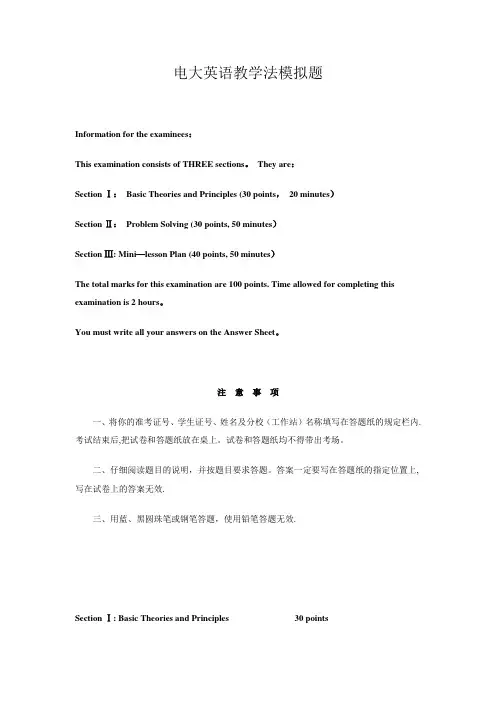
电大英语教学法模拟题Information for the examinees:This examination consists of THREE sections。
They are:Section Ⅰ:Basic Theories and Principles (30 points,20 minutes)Section Ⅱ:Problem Solving (30 points, 50 minutes)Section Ⅲ: Mini—lesson Plan (40 points, 50 minutes)The total marks for this examination are 100 points. Time allowed for completing this examination is 2 hours。
You must write all your answers on the Answer Sheet。
注意事项一、将你的准考证号、学生证号、姓名及分校(工作站)名称填写在答题纸的规定栏内.考试结束后,把试卷和答题纸放在桌上。
试卷和答题纸均不得带出考场。
二、仔细阅读题目的说明,并按题目要求答题。
答案一定要写在答题纸的指定位置上,写在试卷上的答案无效.三、用蓝、黑圆珠笔或钢笔答题,使用铅笔答题无效.Section Ⅰ: Basic Theories and Principles 30 pointsQuestions 1-15 are based on this part。
Directions:Choose the best answer for the following questions and write your answers on the answer sheet.1. Among the factors affecting a lesson plan,which of the following is human factor?A。
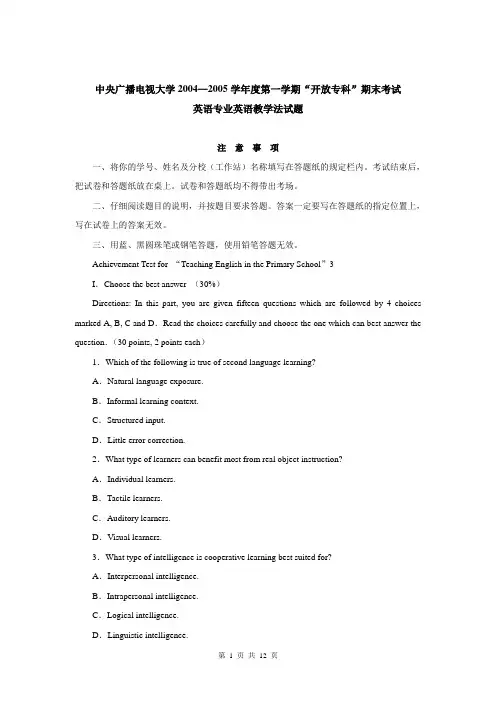
中央广播电视大学2004—2005学年度第一学期“开放专科”期末考试英语专业英语教学法试题注意事项一、将你的学号、姓名及分校(工作站)名称填写在答题纸的规定栏内。
考试结束后,把试卷和答题纸放在桌上。
试卷和答题纸均不得带出考场。
二、仔细阅读题目的说明,并按题目要求答题。
答案一定要写在答题纸的指定位置上,写在试卷上的答案无效。
三、用蓝、黑圆珠笔或钢笔答题,使用铅笔答题无效。
Achievement Test for “Teaching English in the Primary School”3I.Choose the best answer (30%)Directions: In this part, you are given fifteen questions which are followed by 4 choices marked A, B, C and D.Read the choices carefully and choose the one which can best answer the question.(30 points, 2 points each)1.Which of the following is true of second language learning?A.Natural language exposure.B.Informal learning context.C.Structured input.D.Little error correction.2.What type of learners can benefit most from real object instruction?A.Individual learners.B.Tactile learners.C.Auditory learners.D.Visual learners.3.What type of intelligence is cooperative learning best suited for?A.Interpersonal intelligence.B.Intrapersonal intelligence.C.Logical intelligence.D.Linguistic intelligence.4.What does the following practise?※Peer and I went to the cinema yesterday.Peter and ※I went to the cinema yesterday.Peer and I went to the ※cinema yesterday.Peer and I went to the cinema ※yesterday.A.Stress.B.Articulation.C.Liaison.D.Intonation.5.What learning strategy can the following help to train? Match the adjectives on the left with the nouns on the right.A.Grouping.B.Collocation.C.Imitation.D.Imagery.6.Which of the following is a communication game? A.Bingo.B.Word chain.C.Rearranging and describing.D.Cross-word puzzle.7.Which of the following can help train speaking? A.Listen and follow instructions.B.Simon says.C.Pairs finding.D.Match captions with pictures.8.Which of the following activities is most appealing to children’s characteristics?A.Cross-word puzzle.B.Formal grammar instruction.C.Reciting texts.D.Role-play.9.What’s the teacher doing by saying “Who wants to have a try?”?A.Controlling discipline.B.Giving prompt.C.Evaluating students’work.D.Directing students’attention to the lesson.10.Which of the following activities is the most suitable for group work?A.Guessing game.B.Story telling.C.Information-gap.D.Drama performance.11.Which of the following belongs to learning outcomes?A.Role-plays.B.Sequencing pictures.C.Surveys.D.Worksheets.12.Which of the following best describes first language acquisition?A.Care-taker talk.B.Minimal pair practice.C.Selected input.D.Timely error correction.13.Which of the following seating arrangements is most suitable for a whole class discussion?14.What is the teacher doing in terms of error correction?“S: I go to the theatre last night.”T: You GO to the theatre last night?A.Correcting the student’s mistake.B.Hinting that there is a mistake.C.Encouraging peer correction.D.Asking the student whether he really went to the theatre.15.Which of the following questions can be used in the questionnaire for assessing participation?A.Did you get all the questions right in today’s class?B.Did you finish the task on time?C.Can you use the strategies we have learned today?D.What did you do in your group work today?II.Matching (20%)1.Match the learning styles on the left with the type of activities on the right.(4 points)1)Visual learners A.Handwork2)Kinesthetic learners B.Picture talking3)Auditory learners C.Play acting4)Tactile learners D.Song and music listening2.Match the types of intelligence on the left with the form of learning on the right.(4 points)1)Linguistic intelligence A.Doing hands-on activities2)Match and logical thinking B.Sketching3)Spatial intelligence C.Verbalizing4)Bodily/Kinesthetic inteligence D.Conceptualizing3.Match the activities on the left with the language focus on the right.(4 points)1)Grouping words together A.Reading2)Minimal pair practice B.Vocabulary learning strategy3)Labeling pictures C.Pronunciation4)Sequencing the events according to the story D.Writing4.What is the teacher doing? (4 points)1)Now, you can begin. A.Checking understanding2)All right, I think it is time. B.Ending the activity3)Can you two show us how to work? C.Demonstrating the operation4)We are going to do two D.Giving the startthings today. Tom, canyou tell us what they are?5.Match the activities with the relevant classroom arrangement.(4 points)1)Speaking chains A.Whole class work2)Role play of a dialogue B.Individual work3)Guessing the object C.Pair work4)Sentence completion D.Group workⅢ.Multiple choice questions (10%)Directions: In this part, you are given five questions which are followed by 4 choices marked A, B, C and D.Read the choices carefully and choose the suitable answer(s)to the question.You may have more than one answer to each question.(10 points, 2 points each)1.Which of the following roles do the primary school teachers play?A.A prompter.B.A participant.C.An assessor.D.A controller.2.Which of the following features are true of children in learning a language?A.Children can not concentrate for very long.B.Children learn English because they think it interesting.C.Children are not good at planning and monitoring.D.Children are good at understanding concrete things.3.Which of the following belong to formative assessment?A.Learner portfolio.B.Test results.C.Classroom observation.D.Student diaries.4.Which statement of Chinese and English phonetic systems are right?A.English has as many as 24 vowels, while Chinese has none.B.English has a lot of combined consonants, while Chinese has none.C.Stress can change the meaning of a word in English, and tone can also change the meaning in Chinese.D.English words often have more than one syllable, while Chinese characters usually have only one syllable.5.If the class is noisy, which of the following should you choose to settle the class?A.Ask the whole class to copy a list of food words onto a piece of paper from the board.B.Ask the pupils to listen and write down the number of pictures you stick on the blackboard.C.Ask the children to take out their cards and do paired practice.D.Ask children to prepare the dialogue to get ready to act.Ⅳ.Short Answer Questions (20%)Directions: In this part there are four questions about English Teaching Methodology.Writedown your answers in brief.You will be assessed in the points you present and the way you present them.(20 points, 5 points each)1.Why is it necessary to use L1 in foreign language instruction? Give at least two reasons.2.What are the relationship and differences between testing and assessment?3.What does the following support, formative assessment or summative assessment? Why or why not?4.What might be the reason if your students misbehave in class? Mention at least 3 reasons.V.Activity designing (20%)Directions: In this part, you are to design a 10-minute speaking activity according to the material given.The activity should involve the function of ordering and the relevant structures.Make sure you include all the items of an activity according to the table given(objective, organization type, procedure, assumed time, predicted problems and solutions).Make sure you give the assumed time for each step.试卷代号:2145中央广播电视大学2004—2005学年度第一学期“开放专科”期末考试英语专业英语教学法试题答案及评分标准(供参考)2005年1月Ⅰ.Choose the best answer本题为单选题,共15个小题,30分,每题2分。
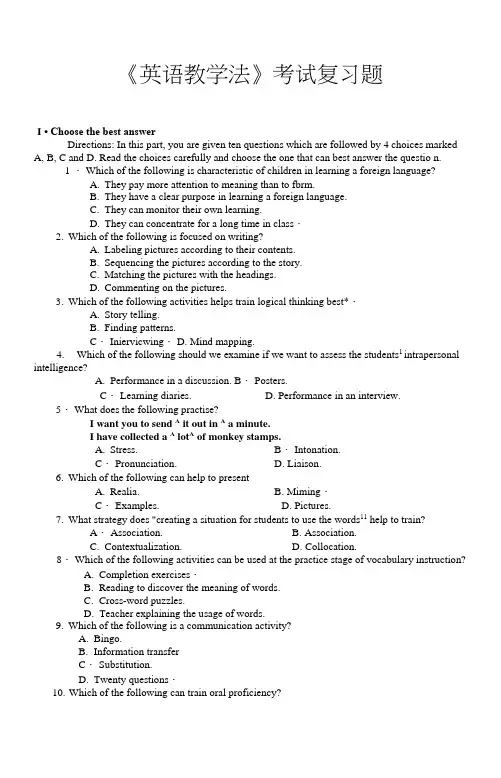
《英语教学法》考试复习题I • Choose the best answerDirections: In this part, you are given ten questions which are followed by 4 choices marked A, B, C and D. Read the choices carefully and choose the one that can best answer the questio n.1 ・ Which of the following is characteristic of children in learning a foreign language?A.They pay more attention to meaning than to fbrm.B.They have a clear purpose in learning a foreign language.C.They can monitor their own learning.D.They can concentrate for a long time in class・2.Which of the following is focused on writing?beling pictures according to their contents.B.Sequencing the pictures according to the story.C.Matching the pictures with the headings.menting on the pictures.3.Which of the following activities helps train logical thinking best*・A.Story telling.B.Finding patterns.C・ Iniervicwing・ D. Mind mapping.4.Which of the following should we examine if we want to assess the students1 intrapersonal intelligence?A.Performance in a discussion. B・ Posters.C・ Learning diaries. D. Performance in an interview.5・ What does the following practise?I want you to send A it out in A a minute.I have collected a A lot A of monkey stamps.A.Stress. B・ Intonation.C・ Pronunciation. D. Liaison.6.Which of the following can help to presentA.Realia.B. Miming・C・ Examples. D. Pictures.7.What strategy does "creating a situation for students to use the words11 help to train?A・ Association. B. Association.C.Contextualization.D. Collocation.8・ Which of the following activities can be used at the practice stage of vocabulary instruction?pletion exercises・B.Reading to discover the meaning of words.C.Cross-word puzzles.D.Teacher explaining the usage of words.9.Which of the following is a communication activity?A.Bingo.rmation transferC・ Substitution.D.Twenty questions・10.Which of the following can train oral proficiency?A. Flow chart dialogue.B. Distant dictation.C. Sequencing pictures.D. Labeling pictures.11 ・ Which of the following activities help to train reading?A. Drawing according to oral instructions ・B. Designing praising cards.C. Commenting on pictures,D. Matching the pictures with different stories.12. Which of the following seating arrngements is most suitable for group discussion?13. What is the teacher doing by saying "Now you are going to do this in pairs. H ?A. Setting up tasks.B. Controlling discipline. C ・ Demonstrating ・ D ・ Getting feedback. 14. Which of the following activities is most suitable for whole-class work?A ・ Presenting new language ・ B. Role-play.C. Infoirnation gap ・ D ・ Writing summaries.15. Which of the following belongs to physical factors that affect the designing of a lesson plan?A. Students 1 needs ・B ・ Students 1 background ・C. Student language proficiency ・D. Syllabus requirements.16. What type of learners can benefit most from acting activities? A. Kinesthetic learners. B. Auditory learners. C. Individual learners ・ D. visual learners M,17. What learning strategy does the following activity help to train?Put the words in the relevant columns* Bananas, dogs, sheep, oranges.FoodFruit .•• 1Animals・ • \ ・二宀•- •-J吕 吕•吕=• =吕•• (=)吕 吕T吕A.CZZJ CZ3 1=) [=] czz C=) (ZZD (=□ (=)czzo (=)(=3 TC=Jc.B.D.A.Grouping.B. Collocation・C. Association.D. Imagery.1& Which of the following can train listening?A.Sequencing the pictures.B.Writing captions for pictures.C.TPR.D.Matching titles with different paragraphs・19. Which of the following activities involves writing?A・ Labeling pictures.B・ Matching pictures with labels.C.Dramatization.D.Role play.20How do children learn their first language?:A.By imitationsB.By being corrected by parents・C.By leaming language rules.D.By, acting and performing・21• What's the teacher doing by saying ”Now you are going to do this in pairs. ?A.Checking understanding.B.Giving prompt・C・ Setting tasks.D. Getting feedback22.Which of the:following activities can be best done with pair work?rmation gap;B.Guessing gamesC.Watching videos・D.Role-play.23.Which Of the following helps assess language performance?A.Asking students to reflect on what activities attract them most.B.Asking students about their attitudes towards a Certain gameC.Asking students to draw pictures according to description?D.Asking the students to do a quiz at the end of the lesson・24.Which of the following is suitable for Speaking?A.TPR actions.B.Recognizing pictures.C・ In formation-gap.D・ Matching pictures with descriptions.25.In which of the following activities does the teacher play the role,of prompter?A.Give suggestions during an activityB.Read out the new words to the students・C.Take part in the pupils,convcrsation.D.Encourage students to go on with their talk・26.Which of the following belongs to projects?A. Guessing what someone is eating ・B. Creating a poster.C. Listening and identifying ・D. Information gap.27. What kind of classroom arrangement is most suitable for the following activites? The teacher asksthe pupils to discuss what they are going to do at the weekend.A. Pair work ・ B ・ Group work. C. Whole-class work. D. Individual work.28. What is the teaching doing in the following part of instruction?T: All right, I think it is the time. A. Introducing the activity. B ・ Giving a start ・C ・ Checking understanding D. Concluding an activity ・29, What is the teacher doing in terms of error correction?S: I seed a very good "film on TV yesterday. T: You SAW a very good film yesterday? A. Helping, correct the mistakeB. Giving a hint that the student has used the wrong tense, C ・ Asking the student to correct the mistake himself D. Asking the student whether he really saw the film.30: What does children% short attention span imply for classroom instruction?.A. We should not make any activity too long ・B. We should not waste time explaining complicated language rules. C ・ We should provide good models for children to imitate.D. We should select to those topics relevant to students^ experience. II. MatchingDirections: In this part, you are given five questions, Each question is followed by two columns of options- You are to match the options on the left marked 1), 2), 3), 4) with relevant options on the right marked A, B, C and D, and write the answers on the answer sheet. Make sure each option can only match with one another.1. Match the learning styles on the left with the type of activities on the right.1) Group learners. 2) Individual learners. 3) Visual learners ・ 4) Tactile learners. 2. Match the teachefs actio ns on both sides.3. Match the activities on the left with the focus of instruction on the right.1) Complete the sentences according to the pictures. A. Listening.A ・ Cutting paper. B. Watching videos. C ・ Discussing weekend plans. D. Doing reading practice. 1) S: I seed a film yesterday. T: Mum? A. Helping the student to correct hisown mistakes ・ 2) S: I seed a film yesterday. T: You SEED a film yesterday? 3) S: I seed a film yesterday. T: You should say H saw M , not “seed”.4) S: I seed a film yesterday ・ T: What did Tom do? Anyone, who can tell us?B. Giving hints that there are mistakesin his speech. C. Encouraging others to correct themistake.D ・ Correcting the students mistakesdirectly ・2) Put the sentences in the correct order according to the pictures.3) Decide on the right pictures according to the recording ・4) Discuss hobbies according to the pictures- 4. Match the activities with the relevant classroom arrangement.1) Chain retelling of a story. 2) Flow-chat dialogue ・ 3) Forming a basketball team. 4) Sentence completion 5. Match the questions with the items they assess.1) What problems do you still have? 2) How well did you prepare before class? 3) How well did you work in your group work?D. Self-regulation. 6. Match the learning styles on the left with thetype of activities on the right.1) Group learners A. Discussion 2) Reflective learners B. Making judgments 3) Individual learners C ・ Copying 4) Tactile learners D ・ Ding handcrafts7. Match the type Of intelligence on the left with the stuitable activities on the right.1) Inteipersonal intelligence.? 2) Musical intelligence, 3) Naturalistic intelligence 4) Spatial intelligence 8. Match the items of phonetics on the left with the realizations on the right1) Articulation A. Not at all 2) Intonation B. She sells seashells by the seashore 3) Liaison C.. Want to do 4) Loss of explosion D. Do you speak ,English?9. Match the type of vacabulaiy learning strategies on the left with the activities that help to train them on the right.1) Collocation A. Ask the students to find .the words from take dialogue and: guess their meanings 2) ContextB. B. 3) Grouping C.Ask the students to the words I n the right category.4) Imitation D. Ask the students to match the prepositions with the nouns. 10. Match the type of activities on the left with :the focus on the right?1) Simon says A. Reading 2) Look and say B. Writing; 3) Sentence completion C. Speaking 4) Drawing according, to instruction D. Listening HL Multiple choice questionsDirections: In this part, you are given ten questions which are followed by 4 choices marked A, B, C and D. Read the choices carefully and choose the one(s) you think suitable. Yon may have more than one answer to each question.1 ・ Which of the following roles do the primary school teachers play?A ・ A helpe 匚 B. A motivator.B. Speaking.C. Reading ・D. Writing. A. Whole class work. B. Individual work ・ C. Pair work ・ D ・ Group work. A. Language performanee. B. Progress. C ・ Classroom participation.4) Flow well did you do in the vocabulary quiz?A. Active imaginationB. Rhythmic patternsC. Sensing others' motives,D. Photographing a good AsktheStudentstolistentoarecort and read after it.C.A friend.D. An organizer.2.Which of the following are/is characteristic of children?A.Not afraid of making mistakes.B.Analytical in learning・C.More instrumentally motivated.D.Good at generalizing.3.Which of the following explain(s) how children acquire their first language?A.By experimenting with the language.B.By interacting with people around them.C.By mimicking.D.By attending lessons.4.Which of the following features the learning of a foreign language?A. Natural learning context.B. Structured input.C.Conscious learning.D. Little error correction.5.Which of the following give(s) the right explanation of Chinese and English phonetic systems?A. English differentiates stressed syllables and unstressed syllables, and so does Chinese. B・Both English and Chinese have many vowels.C.Both English and Chinese have a lot of combined consonants・D・ English words often have two or more syllables, but Chinese characters have only one.6・.If the class is too passive and lifeless, what will you do?A.Ask the students to read out the text togethe匚B.Ask the students to copy the text.C・ Ask students to act out the dialogue・D.Ask the students to do guessing games7. What is practiced in the following activity?Now, work in pairs and ask your partner what he or she has in his or her schoolbag.A.Vocabulary・B.Speaking・C・ Listening.D.Grammar.& Which two of the* following should be the focus of oral instruction?nguageB.Function.C・ FluencyD.Knowledge9.Which of the following are true of second language learning?A.Structured input.B.Selected exposure.C: Natural contextD・ Focus on communication10.Which of the following can provide data for informative assessment?A.Final-term examinationB.Classroom observation.C.Peer evaluation of studentsD.Students1 learning diary.IV. Activity designing :I.In this part, you are to design a 10-minute speaking activity according to the material given. The activity should be based on the following dialogue and make use of the pictures given.Make sure yon include all the items of an activity described in the textbook objective, organization, assumed time, procedure, predicted problems and solutions)・ You can f rife your design of the activity according to the table given. Make sure you give the assumed me for each step.Tom: Do you miss China?Darning: Sometimes.Tom: Do you want to go to China with me?Darning: Chinatown? But this is America.om: There is a Chinatown in New York! There are a lot of Chinese shops and restaurants there ・Darning: Really?Tom: Yes, and there's Chinese dancing. Darning: Let's go to Chinatown now.II.activity according to the material given. The activity should be based on the material. Make sure you include all the items of an activity according to the table given (objective, organization type, assumed time, predicted problems and solutions, procedures including assigning the tasks; students preparing in groups; getting feedback). Make sure you give the assumed time for each step.TEXTA: Look, there he is.B: Who?A: Robert, the guy I've been telling you about.B: Oh・ The guy you're going out with?A: I wish. The guy I want to go out with.B: Oh, he he's really handsome. Um, lets go talk to him.A: Oh, OK. Ell introduce you. I think yoif 11 really like him...Hi, Robert・C: Oh, hi.A: Have you met my friend, Jean?C: Fm afraid not.A: Hey, Jean, this is Robert. Robert, this is Jean.C: Nice to meet you, Jean.B: Nice to meet you . Robert.Please design a 10-minute communicative speaking activity according to the material given. In this speaking activity, you are to train the students to learn how to greet people and make introduction.1.Objectives (2%) ___________________________________2.Classroom organization (2%) _________________________________3・ Assumed time (2%) ______________________________4.Predicted problems (2%) _______________5.Solutions (3%) ______________________________6.Procedure (9%)(1)Assigning the tasks _____________________________(2)Students preparing in pairs _________________________(3)Getting feedback _________________________________III. Activity designing (20%)Directions: In this part, you are to design a 10-minute communicative speaking activity according to the material given. The activity should be based on the material. Make sure you include all the items of an activity according to the table given (objective, organization type, procedure (at least 3 procedures), assumed time, predicted problems and solutions). Make sure you give the assumed time for each step・TEXTA: Hi, Susan. Have you got any plans for the weekend?B: No, not really. Why?A: Well, Bill and I were thinking of giving a party. Would you like to come?B: Fd love to. What can I bring?A: Nothing .Just yourself. Oh, I almost forgot.Could you tell the girls in your dorm about the party?B: Sure. By the way, what time do you want people to show up?A: Around seven. And also please tell the girls not to wear anything formal・It will be a casual affai匚B: Okay.Name of activity ( 1%)_________________Objectives (1%) ___________________________________Type of the activity (1%) _____________________Classroom organization (1%) ____________________________Teacher's role (1%) ______________________Students^role (1%) ______________________Assumed time (1 %) ______________Predicted problems (2%) ________________Solutions (2%) ______________________________Procedure (9%)(1)Assigning the tasks ______________________________(2)Students preparing in pairs __________________________(3)Getting feed back _________________________________。
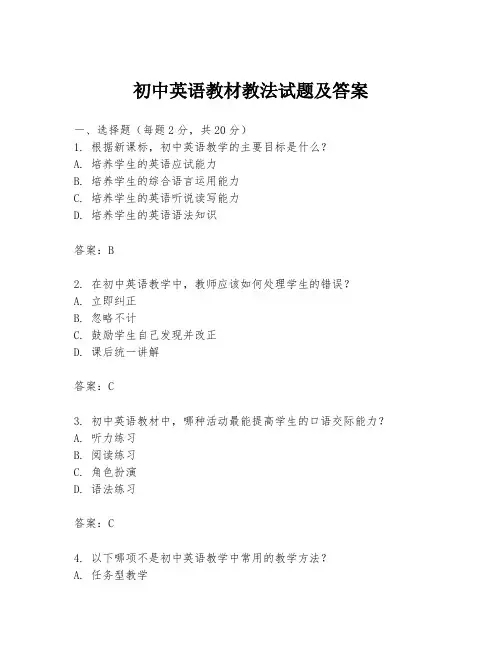
初中英语教材教法试题及答案一、选择题(每题2分,共20分)1. 根据新课标,初中英语教学的主要目标是什么?A. 培养学生的英语应试能力B. 培养学生的综合语言运用能力C. 培养学生的英语听说读写能力D. 培养学生的英语语法知识答案:B2. 在初中英语教学中,教师应该如何处理学生的错误?A. 立即纠正B. 忽略不计C. 鼓励学生自己发现并改正D. 课后统一讲解答案:C3. 初中英语教材中,哪种活动最能提高学生的口语交际能力?A. 听力练习B. 阅读练习C. 角色扮演D. 语法练习答案:C4. 以下哪项不是初中英语教学中常用的教学方法?A. 任务型教学B. 情景教学C. 直接教学D. 翻译教学答案:D5. 初中英语教师在课堂上应该扮演什么角色?A. 知识的传授者B. 学习的引导者C. 课堂的管理者D. 以上都是答案:D6. 在初中英语教学中,教师应该如何对待学生的个体差异?A. 忽视差异,统一要求B. 根据差异,因材施教C. 鼓励学生相互竞争D. 只关注优秀学生答案:B7. 初中英语教材中,哪种类型的练习最适合培养学生的创新思维?A. 填空题B. 选择题C. 完形填空D. 写作题答案:D8. 初中英语教师在备课时,应该重点关注哪些方面?A. 教材内容B. 学生需求C. 教学方法D. 教学目标答案:D9. 在初中英语教学中,教师应该如何激发学生的学习兴趣?A. 通过游戏和活动B. 通过考试和竞赛C. 通过严格的课堂纪律D. 通过大量的作业答案:A10. 初中英语教学中,教师应该如何处理学生的课堂参与度?A. 强制学生参与B. 鼓励学生自愿参与C. 忽视不参与的学生D. 只关注积极参与的学生答案:B二、填空题(每题2分,共10分)1. 初中英语教学应该注重培养学生的______能力,而不仅仅是应试技巧。
答案:综合语言运用2. 在初中英语课堂上,教师应该鼓励学生进行______,以提高他们的口语交际能力。
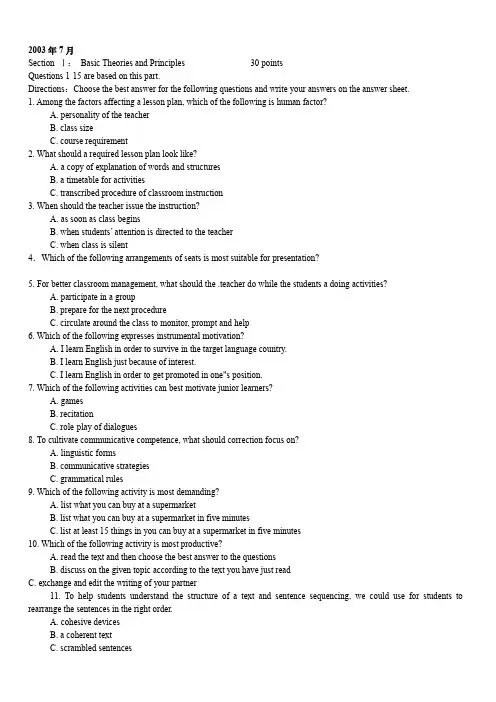
2003年7月Section Ⅰ:Basic Theories and Principles 30 pointsQuestions 1-15 are based on this part.Directions:Choose the best answer for the following questions and write your answers on the answer sheet.1. Among the factors affecting a lesson plan, which of the following is human factor?A. personality of the teacherB. class sizeC. course requirement2. What should a required lesson plan look like?A. a copy of explanation of words and structuresB. a timetable for activitiesC. transcribed procedure of classroom instruction3. When should the teacher issue the instruction?A. as soon as class beginsB. when students’ attention is directed to the teacherC. when class is silent4.Which of the following arrangements of seats is most suitable for presentation?5. For better classroom management, what should the .teacher do while the students a doing activities?A. participate in a groupB. prepare for the next procedureC. circulate around the class to monitor, prompt and help6. Which of the following expresses instrumental motivation?A. I learn English in order to survive in the target language country.B. I learn English just because of interest.C. I learn English in order to get promoted in one"s position.7. Which of the following activities can best motivate junior learners?A. gamesB. recitationC. role-play of dialogues8. To cultivate communicative competence, what should correction focus on?A. linguistic formsB. communicative strategiesC. grammatical rules9. Which of the following activity is most demanding?A. list what you can buy at a supermarketB. list what you can buy at a supermarket in five minutesC. list at least 15 things in you can buy at a supermarket in five minutes10. Which of the following activity is most productive?A. read the text and then choose the best answer to the questionsB. discuss on the given topic according to the text you have just readC. exchange and edit the writing of your partner11. To help students understand the structure of a text and sentence sequencing, we could use for students to rearrange the sentences in the right order.A. cohesive devicesB. a coherent textC. scrambled sentences12. The purpose of the outline is to enable the students to have a clear organization of ideas and a structure that can guide them .A. in the actual writingB. in free writingC. in controlled writing13. tell you what you should use in order to produce accurate utterances.A. The descriptive grammarB. The prescriptive grammarC. The traditional grammar14. The grammar rules are often given first and explained to the students and then the students have to apply the rules to given situations. This approach is called .A. deductive grammar teachingB. inductive grammar teachingC. prescriptive grammar teaching15. It is easier for students to remember new words if they are designed inand if they are and again and again in situations and contexts.A. context, sameB. context, differentC. concept, difficultSection Ⅱ:Problem Solving 30 pointsDirections:Five situations in classroom teaching are provided here. In each situation there are some problems. Firstly, identify the problems; Secondly, provide your own solutions according to the communicative language teaching principles. You must elaborate on the problem (s) and solutions in about 50-70 words.Situation 1In a writing lesson, the teacher writes the topic "Environmental Awareness" on the blackboard, and then asks the students to write an essay of 150 words in half an hour in class. Half an hour later, the teacher collects the writings.Situation 2At the practice stage of a grammar lesson, the teacher designs an activity with multiple choice questions to practise the grammatical items the students learned.Situation 3At the production stage of a speaking lesson, the teacher divides the students into 6 groups to do the discussion. And then the teacher retreats to a corner of the classroom to prepare for the next activity.Situation 4In an oral class, a teacher asks students to answer questions. To ensure smooth progress of his lesson, he always asks the excellent students to answer questions.Situation 5In a reading lesson, at the while-reading stage, the teacher assigns some skimming tasks, but some students are consulting their dictionaries for new words and expressions. The teacher notices all this but pretends not to see.Section Ⅲ:Mini-lesson Plan 40 pointsDirections:Read the following two texts carefully and complete the teaching plans.1. The following is an abstract from Senior Ⅰ, Student Book. Please design a teaching plan with the text.Write about a well-known person from Chinese history.2. The following is an abstract from Senior Ⅱ, Student Book. Please design a teaching plan with the text.Grammar Noun Clauses as the AppositiveThe idea that computers will recognize human voices surprises many people.The possibility that the majority of the labor force will work at home is often discussed.Section Ⅰ:Basic Theories and Principles 30 points1.A 2.C 3.B 4.B 5.C6.C 7.A 8.B 9.C 10.B11.C 12.A 13.B 14.A 15.BSection Ⅱ:Problem Solving 30 points共30分,每题6分(找出问题得3分,根据交际法原则提出合理的解决方案得3分,问题和解决方案应有50至70词的阐述,并应基本包括参考答案所涉及的要点。
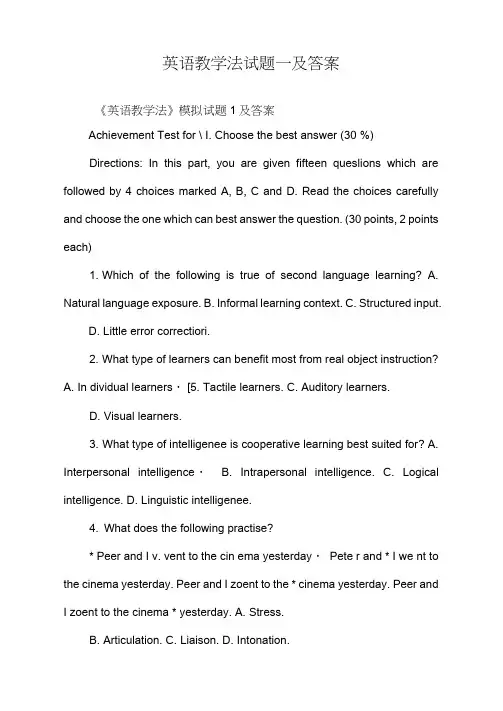
英语教学法试题一及答案《英语教学法》模拟试题1及答案Achievement Test for \ I. Choose the best answer (30 %)Directions: In this part, you are given fifteen queslions which are followed by 4 choices marked A, B, C and D. Read the choices carefully and choose the one which can best answer the question. (30 points, 2 points each)1.Which of the following is true of second language learning? A. Natural language exposure. B. Informal learning context. C. Structured input.D. Little error correctiori.2.What type of learners can benefit most from real object instruction?A. In dividual learners ・[5. Tactile learners. C. Auditory learners.D. Visual learners.3.What type of intelligenee is cooperative learning best suited for? A. Interpersonal intelligence・ B. Intrapersonal intelligence. C. Logical intelligence. D. Linguistic intelligenee.4.What does the following practise?* Peer and I v. vent to the cin ema yesterday ・ Pete r and * I we nt to the cinema yesterday. Peer and I zoent to the * cinema yesterday. Peer and I zoent to the cinema * yesterday. A. Stress.B.Articulation.C. Liaison.D. Intonation.5.What learning strategy can the following help to train? Match the adjectives on the left with the nouns on the right・ H cavy Day Nice Baby Close Building Light Rain Tall Friend Cute Smoker A. Grouping.B.Collocation.C. Imitation.D. Imagery・6.Which of the following is a communication game? A. Bingo.B.Word chain.C.Rearranging and describing.D. Cross-word puzzle・7.Which of the following can help train speaking? A. Listen and follow instructions. B. Simon says. C. Pairs finding.D.Match captions with pictures・8.Which of the following activities is most appealing to children\A.Cross-wo rd puzzle.B.Formal grammar instruction.C. Reciting texts・D. Role-play.9.What\ A Controlling discipline. B. Giving prompt・C.Eva[uating students\D.Directing stude nts 〜attenti on to the less on.20. Which of the following activities is the most suitable for group work? A. Guessing game・B. Storytelling.C. Information-gap・D. Drama performance.1 i. Which of the following belongs to learning outcomes? A. Role-plays,B, Sequencing pictures・ C・ Surveys・ D・ Worksheets.22.Which of the following best describes first language acquisition?A. Care-taker talk・B. Minimal pair practice・C. Selected input.D. Timely error correction.23.Which of the following seating arrangements is most suitable fora whole class discussion?24・ What is the teacher doing in terms of error correction? \T: You GO to the theatre last night?A. CorrectingXB. Hinting that there is a mistake.C. Encouraging peer correctio n.D. Asking the Student whether he really went to the theatre.15. Which of the following questions can be used in the questiorinaire for assessing participation?A. Did you get all the questions right in today\B. Did you finish the task on time?C.Can you use the strategies we have learned today?D. What did you do in your group work today? II. Matchi ng (20%)1.Match the learning styles on the left with the type of activities on the right. (4 points)1)Visual lear ne「s A. Handwork 2) Kin esthetic learners B. Picturetalking 3) Auditory learners C. Play acting4) Tactile learners D. Song and music listening2.Match the types of intelligence on the left with the form of learning on the right. (4 points) 1) Linguistic intelligence A. Doing hands-on activities2) Match and logical B. Sketching thinking3)Spatial intelligence C. Verbalizing 4) Bodily/Kinesthetic D. Conceptualizing inteligenee3.Match the activities on the left with the Ianguage focus on the right.(4 points) 1) Grouping words together A・ Reading2)Minimal pair practice B. Vocabulary learning strategy 3) Labeling pictures C. Pronunciation 4) Sequencing the events D. Writing according to the story4.What is the teacher doing? (4 points)1)Now, you can begin. A. Checking understanding 2) All right, I think it is time・ B・ Ending the activity3)Can you two show us how to work? C・Dem on strating the operation 4) We are going to do two D. Giving the start things today. Tom, can you tell us what they are?5.Match the activities with the releva nt classroom arrangement. (4? points) 1) Speaking chains A. Whole class work 2) Role play of a dialogue B. Individual work 3) Guessing the object C. Pair work 4) Sente nee completi on D. Group work III. Multiple choice questi ons (10 %)Directions: In this part, you are given five questions which are followed by 4 choicesmarked A, B, C and D. Read the choices carefully and choose the suitable answer(s) to the question. You may have more than one answer to each question. (20 points? 2 points each) 2. Which of the following roles do the primary school teachers play? A. A prompter. B. A participant. C. An assessor. D. A controller.2.Which of the following features are true of children in learning a Ianguage? A. Children can not concentrate for very long.B.Children learn English because they think it interesting.C. Children are not good at planning and monitoring.D. Children are good at un d erst a nding con crete things. 3. Which of the followi ng belong to formative assessment?A.Learner portfolio.B. Test results.C.Classroom observation.D. Student diaries.4.Which statement of Chinese and English phonetic systems are right?A. English has as many as 24 vowels, while Chinese has none.B.English has a lot of combined cons on ants, while Chinese has none.C.Stress can change the meaning of a word in English, and tone can also change the meaning in Chinese.D.English words often have more than one syllable? while Chinese characters usually have only one syllable・5.If the class is noisy, which of the following should you choose to settle the class?A. Ask the whole class to copy a list of food words onto a piece of paper from the board.B. Ask the pupils to listen and write down the number of pictures you stick on the blackboard.C. Ask the children to take out their cards and do paired practice.D.Ask children to prepare the dialogue to get ready to act. IV: Short Answer Questions (20 %)Directions: In this part there are four questions about English Teaching Methodology・ Write down your answers in brief. You will be assessed in the points you present and the way you present them. (20 points, 5 points each)2.Why is it necessary to use LI in foreign Ianguage instruction? Give at least two reasons・ 2. What are the relationship and differences between testing and assessment?3.What does the following support, formative assessment or summative assessment? Why or why not? Self--assessment Sheet Yes, Partly. No 1.丨was able to select a story I am interested in. □ □ □ 2・丨tried to guess from the context when I met [] □ 0 new words in the story. 3. When I [ailed to guess out the words, I referred □ 0 □ to the Chinese version for reference・4.1 skimmed the story to first find what it is □ □ [] mainly abou匸5.1 then read the story carefully, interested in□□ □ some of the details. 6. When I was requir ed to retell a character I like [][][] best or a happening which attracted my attention, I seanned the story again for some details. 7. In the discussion with others I found that I was □ 0 □ able to get the right information very quickly as I read in the w ay I had learnt. 8.丨am satisfied with my reading this time・□ □□4. What might be the reason if your students misbehave in class? Mention at least 3 reasons.Directio ns:In this part, you are to design a IO--minute speaking activity according to the material given. The activity should involve tile function of ordering and the r e leva nt structures. Make sure you include all the items of an activity according to the table given (objective,organization type, procedure, assumed time, predicted problems and solutions) . Make sure you give the assumed time for each step.参考答案I ・ Choose the best answer本题为单选题,共15个小题,30分,每题2分。
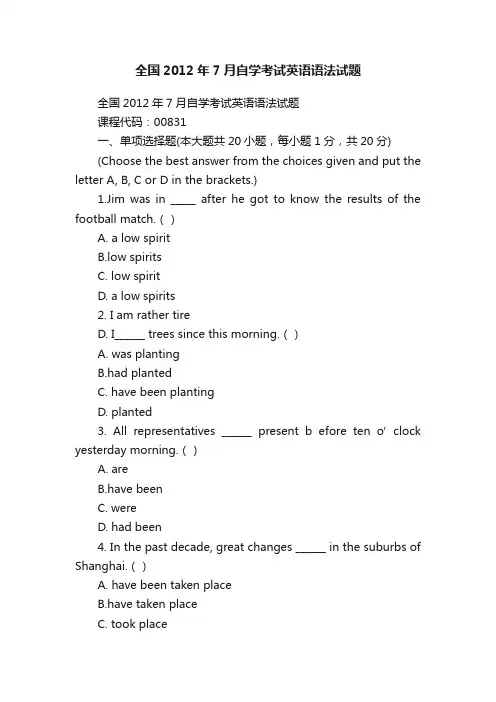
全国2012年7月自学考试英语语法试题全国2012年7月自学考试英语语法试题课程代码:00831一、单项选择题(本大题共20小题,每小题1分,共20分)(Choose the best answer from the choices given and put the letter A, B, C or D in the brackets.)1.Jim was in _____ after he got to know the results of the football match.()A. a low spiritB.low spiritsC. low spiritD. a low spirits2. I am rather tireD. I______ trees since this morning.()A. was plantingB.had plantedC. have been plantingD. planted3. All representatives ______ present b efore ten o’clock yesterday morning.()A. areB.have beenC. wereD. had been4. In the past decade, great changes ______ in the suburbs of Shanghai.()A. have been taken placeB.have taken placeC. took placeD. were taken place5. They envy George because of his ______ chairman of the committee.( )A. having appointedB.having been appointedC. appointedD. being appointed6. I wish I ______ longer this morning, but I had to go to school at 7 o’clock.()A. could sleepB.could have sleptC. sleptD. have slept7. Every adult ______ be responsible for what he or she has done.( )A. canB.couldC. should D may8. If you favor ______on night shift, you may go and tell the manager.()A. to workB.workingC. having workedD. being worked9. The student confessed to ______a lie to the teacher.()A. have toldB.having toldC. tellD. being told10. I have no objection to ______ a trip to Hawaii again.()B.havingC. having hadD. have had11. These customs are common in Northern China and to a______ extent in Southern China.( )A. littleB.lessC. lesserD. least12. Don’t think t hat these people are ______you.( )A. inferior thanB.more inferior thanC. inferior toD. inferior as13. I’m leaving tomorrow. ______, can I use your car for shopping this afternoon?()A. In the wayB. On the wayC. By the wayD. Through the wayl4. Don’t get mad ______ the children. They don’t even know what they ’ ve done.()A. forB.ofC. atD. by15. That was the kind of person _______he was.()A. whoB.whomD. which6. The villagers, ______ had been damaged by the earthquake, were given help by the RedCross.()A. all their homesB.all whose homesC. all of whose homesD. all of their homes7. All ______ glitters is not golD.()A. whichB.whoC. /D. that18. This tenth and last book of his ______ when he was bed-ridden.()A. was writtenB.were writtenC. has been writtenD. had been written19. Each family ______ asked to plant a tree before summer came.()A. isB.areC. wasD. were20. I have both tea and coffee.______ do you prefer?()A. WhichB.WhatC. Which oneD. What one二、填空题(本大题共28小题,共36分)Section A: Fill in the blanks with the appropriate words given in the group.(共8小题,每小题2分,共16分)21. is, will be, are, their, one’s, hisMore than one person _________ going to lose _________ job.22. a, all each, some, the, suchEric didn’t even have_________ common sense to send for ________ doctor.23. watch, watching, to watch, been operated, being operated, operateI want you ________ carefully how the machine is __________ .24. were, be, is, talk, talks, will talkIt ________ important that she _________ to him in person.25. whether; however, whatever, is it, the reason, it is the reason________ ________, physical punishment to children at school is illegal.26. which, what, when, where, whom, whoThis is the man ________ drove the car __________ his wife bought from the car dealer. 27. was, were, being, its, their , one’s The audience ________ excited on seeing ________ favourite star glide onto the stage. 28. it, them, him, that, what, which He found ________ annoying ______ his neighbour kept calling him by the wrong name. Section B: Fill in the blanks with the words given in brackets. Make changes or addsomething where necessary.(共20小题,每小题1分,共20分)29. That may be your lost car, _________ (it)?30. __________ (much) I admire him ,I don’t like all his work31.These are the ________ (criteria) we use to select candidates.32. You can’t have it ______ (ways) -you either work longer and get paid more or have more leisure time and get paid less.33. She has read a book about the poor _______ (peasant) childhood and their early life.34. The man ________ (try) to climb out of the window when the firemen arrived35. He lay on the ground as though he _________ (shoot).36. It’s the third time you ________ (arrive) late this week.37. The movie star is wearing sunglasses lest he __________ (recognize).38.My parents wanted me to be a doctor, but I_______ (not put) up with all those years of study.39. I want to congratulate you on __________ (admit) to the university you like very much.40. ________ (look) ahead to the weekend, temperature will be warmer.41. Also we know that astronauts, when they go up into space, find the air becomes_________(thin) as they go higher.42. Th is is ________ (exciting) birthday party I’ve ever had43. I want to tell you that we all________ (sympathize) you in your afflictions.44. To ________ (keep) confusing your readers, always put modifying phrases and clauses near the words they modify.45.________ (grant) that it is a simple test to perform, it should be easy to get results quickly.46. The driver was the man ________ (from) room she hadstolen the maps.47. Every drop of tears, every moan out of pain and every cry for help _______ (be) like knife cutting deep into my heart.48. _________ (remain) three chapters before I finish the book.三、改错题(本大题共12小题,每小题1分,共12分)Correct one error in each of the following sentences.49. He bought two newly published chil dre ns’ books for his son.50. He would tell the truth when they killed him.51. When I entered his office, he didn’t say a word, nor did he raise his head, as if I am in visible.52. ---Would you write to me as soon as you arrive?---Yes, I would53. The West Indies, apart from the Bahamas, are commonly divided into two parts.54. Are you going to buy all these rice?55. You can’t help but to respect them.56. Running into the room, a rug caught her foot and she fell.57. When planting these flowers, care must be taken not to damage the roots.58. Give him an inch, or he’ll take a mile.59. The vessel, with its entire crew and cargo, were lost.60. Not a single article he bought in that department store.四、改写句子(本大题共12小题,每小题2分,共24分)Rewrite the following sentences as required61. Adding a suitable tag to the following statement:Tony rarely has his room cleaned62. Turning the following statement into an exclamation:We’ve had such bad weather f or a whole week.63. Using a non-finite verb form:The last problem that must be considered at our next meeting is how to invest the money.64. Combining the two sentences by using a relative clause:James Russell is a man. I have the greatest respect for him.65. Combining the two sentences by using a conjunct:He is being a fool. He is behaving foolishly.66. Using a disjunct:I will say frankly that I was rather impressed by his manner.67. Using discontinuity:Many forms of apparatus by which a more accurate knowledge of blood pressure can be obtained have been devised68. Using inversion:He had hardly finished his work when the telephone rang.69. Using a modal auxiliary:It’s possible that our tea m will win the race.70. Using whatever cohesive device is appropriate:The production increases as it has increased for the last few years.71. Using whatever cohesive device is appropriate:John was the winner in 1999, and Bob was the winner in 2000.72. Using subjunctive mood:It suffices to say that the open policy will remain unchanged五、简答题(本大题共2小题,每小题4分.共8分)Answer the following questions.73.How can we achieve specific reference (with examples)?74.What are principles governing the subject-verb concord? Give your answer with examples.。
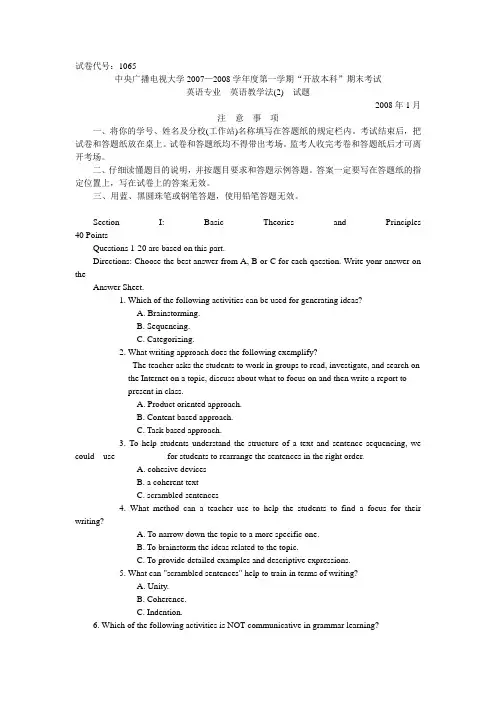
试卷代号:1065中央广播电视大学2007—2008学年度第一学期“开放本科”期末考试英语专业英语教学法(2) 试题2008年1月注意事项一、将你的学号、姓名及分校(工作站)名称填写在答题纸的规定栏内。
考试结束后,把试卷和答题纸放在桌上。
试卷和答题纸均不得带出考场。
监考人收完考卷和答题纸后才可离开考场。
二、仔细读懂题目的说明,并按题目要求和答题示例答题。
答案一定要写在答题纸的指定位置上,写在试卷上的答案无效。
三、用蓝、黑圆珠笔或钢笔答题,使用铅笔答题无效。
Section I: Basic Theories and Principles 40 PointsQuestions 1-20 arc based on this part.Directions: Choose the best answer from A, B or C for each qaestion. Write yonr answer on theAnswer Sheet.1. Which of the following activities can be used for generating ideas?A. Brainstorming.B. Sequencing.C. Categorizing.2. What writing approach does the following exemplify?The teacher asks the students to work in groups to read, investigate, and search onthe Internet on a topic, discuss about what to focus on and then write a report topresent in class.A. Product oriented approach.B. Content based approach.C. Task based approach.3. To help students understand the structure of a text and sentence sequencing, we could use for students to rearrange the sentences in the right order.A. cohesive devicesB. a coherent textC. scrambled sentences4. What method can a teacher use to help the students to find a focus for their writing?A. To narrow down the topic to a more specific one.B. To brainstorm the ideas related to the topic.C. To provide detailed examples and descriptive expressions.5. What can "scrambled sentences" help to train in terms of writing?A. Unity.B. Coherence.C. Indention.6. Which of the following activities is NOT communicative in grammar learning?A. Making a speech on a given topic.B. Filling the blanks with proper verb forms.C. Writing a letter to a family member describing the school life.7. Which of the following grammar activities is most communicative?A. Asking students to complete the sentences concerning the past conditional.B. Asking students to make sentences using past conditional.C. Asking students to tell what they would do if they happened to be infectedwith SARS.8. What stage carl the following grammar activity be used at?The teacher asks the students to arrange the words of the sentences into di.fferent columns marked subject, predicate, object, object complement, ad'verbial and so on.A. Presentation.B. Practice.C. Production.9. Which of the following activities can be used at the practice stage of vocabularyinstruction?A. Completion exercises.B. Reading to discover the meaning of words.C. Cross word puzzles.10. What aspect of vocabulary does "realia" help to present?A. Word information.B. Word grammar.C. Word meaning.11. It is easier for students to remember new words if they are designed in __ andif they are used again and again in __ situations and contexts.A. context, sameB. context, differentC. concept, difficult12. What should a lesson plan be like? Choose the most suitable description from thefollowing.A. A lesson plan is a copy of explanation of words and structures.B. A lesson plan is a transcribed procedure of classroom instruction.C. A lesson plan is a series of activities to conduct in class.13. Among the factors affecting a lesson plan, which of the following is human factor'?A, Personality of the teacher.B. Class size.C. Course requirement.14. Which of the following is among the physical factors that affect lesson planning?A. Teaching aids,B. Students' language learning background.C. Testing.15. What is the teacher doing with tbe students' mistakes? ,T: What did you do last night? Mmm ... George?G: I study my homework.T: Er ." [worried look]G: Aah '" I do my homework '"T: You Do you housework last night?G: Ah '"yes, I did my hotnework,A. Helping self correction.B. Encouraging peer correction.C. Conducting immediate teacher correction.16. In which of the following activities does the teacher play the role of instructor?A. Organizing the pupils to do guessing activities.B. Explaining the functions entailed in the dialogues.C. Walking around the classroom to offer help to those slow students.17. What is the teacher doing in the following in terms of instruction?"We've got one more ?minute left, so make sure that you finish your task on time '".OK, f think it is the time."A. Ending the task.B. Evaluating the task.C. Monitoring the task.18. If you want to present the usage of words, which of the following would you choose?A. Diagrams.B. Picture illustration.C. Examples.19, The teacher is going to present a passage about the weather in the LT. S. What teaching aids are more useful to the effectiveness of the lesson.'?A. Tape Recorder.B. A map of the U. S.C. Blackboard.20. What activity is the following seating arrangemen! most suitable for?A. Group discussion.B. Acting of a play.C. Individual reading of the text.Section II: Lesson plan 60 Points Directions: In this section, you are presented with a short passage. Read the passage and design three activities to train writing based on the passage. The requirement of each activity is as following:~ Reading: analyze the content and writing of the passage~ Writing: write a short passage introducing customs~ Revision: improve writing through peer (Jr group editingYou may follow the table given after the passage. Make sure the three activities are related to each other.Do as the Romans doThere's a saying 'When in Roche, do as the Romans do. ' And when you eat western food, do as the Westerners do. Here are .some things you may wish to know about eating together in the West.In the West, lunch is eaten later, always after midday, sometimes at one o ~ clock.Dinner is served around 7pm or even later. Iii Spain it's usual to eat lunch at 2pm anddinner at lOpm!At the start of a meal the Chinese usually say manman chi The French say Bon appetit, and the Italians say Buon appetito. But there's no similar e:cpression in English !Enjoy your meal ! is usually only said by a waiter. For gan bei , you can say Cheers !Chopsticks are only used when people eat Chinese food. Knives and forks are used for most food. The fork is held in your left hand and the knife in your right, and the food isheld with the fork and cut with the knife. Americans often cut all their food first, thenput the fork in their right hand to eat it. Soup is drunk with a spoon. However, there issome food which can be eaten with your fingers, such as chicken legs, seafood, bread and cake.At the start of the meal, and if you ' re the guest, you'll be invited to serve yourself (' Help yourself ! '), or your plate will be filled by your host (' Can ] serve you ? ') Ifyou ' ye been given something you don't like, it should be pushed to the edge of the plate and left. You don't have to say why, but if you feel an explanation is required, just say,' I'm sorry , I can't eat this.' No one will be cross. If you're o f fered more food, butcan't eat any more, just say, ' No thanks, it was delicious, but I've had enough. 'Generally, fewer dishes are prepared than in China, and much less food will be taken away at the end of the meals. It isn't thought to be so important to offer too much food.Finally, it's sometimes difficult to know when the meal is over. If you've been invited to dinner by Western friends, you' ll know that you're expected to stay and talkaround the dinner table long after the last dish has been brought to the table, and it ' sthought quite rude if' you leave as soon as you finish eating,The golden rule is '" watch the other people. Do as they do.Activity 1 (Reading)Activity 2 (Writing)Activity 3 (Revision)Backup plan:1. Predicted problems2. PossiBle soluiions试卷代号:1065中央广播电视大学2007—2008学年度第一学期“开放本科”期末考试英语专业英语教学法(2) 试题答案及评分标准(供参考)2008年1月Section I. Basic Theories and Principles(共40 分,每题2分)1. A2. C3. C4. A5. B6. B7. C 8, B 9. A 10. C11. B 12. B 13. A 14. A 15. A16. B 17. A 18. C 191 B 20. A Section Il. Lesson Plan(共60 分)每题的评分标准相同,具体如下:参考教案:Activity 1 (Reading)Objectives: to analyze the content and writing of the passageClassroom organization., individual work to pair workTeaching aid: multi media or OIiPAssumed time:8 minutesProcedure:1. Assign the task (1')"Now, class. Today, you are going to write something to introduce the customs of your hometown. Before you take up your pens, let's read the text first. See what is included inthe passage and how it is developed. First read hy yourself. When you have finished, cbeck your understanding with your partner. Now 4 minutes for your work."2. Students work individually to read the text and then work in pairs to talk about the content and the writing mechanism of the text. (4')3. Feedback (3')Call on individual pairs to report their work. Then the teac}mr presents the content and the development of the passage with the multimedia or OHP.Transition:4. T: "OK. When we introduce the customs, we can include ... Now, can you write something to introduce the customs in your hometown?"Activity 2 (Writing)Objectives: to apply the mechanism of writing to introduce customsClassroom organization: individual workTeaching aid: noAssumed lime: 8 minutesTransition5. Assign the task (1'):(continuing 4) "I'd like you to work individually. First think of what you can include in your passage. Then write a short passage using the skills you've Iearnt in this text. ' Procedure6. Individual writing (7 ' )Students work individually to write about the customs in their hometown. While the students are writing, the teacher can circulate around to monitor and render assistance where necessary.Transition:7. T: "Have you finished? If yes, I'd like you to exchange your writing with your partner. 'Activity 3 (Revision)Objectives: to make improvements through peer editingClassroom organization: pair workTeaching aid: muhimediaAssumed time: 6 minutesTransition:8. Assign the task (1 ' )(9 continued) "Read your partner's writing, and give suggestions for improvement"Procedure:9. Pair work (3')Each pair exchanges their writing and does peer-editing, giving suggestions on language, content and the writing mechanism.10. Individual work (2')The teacher first selects two pairs to present on the screen, and give suggestions for improvement. Then each student revises their writing according to the suggestions of the teacher and their partners.Backup planPredicted problems:1. The students may not know what to read for and thus give quite different answers.2. Students may not be able to find out errors or mistakes in writing and thus cannot provide constructive suggestions.Possible solutions:1. The teacher can give the students a table or an outlifie for them lo fill in when read, for example the main idea of each paragraph.2. The teacher can give some guidelines for peer editing so that students can pay their attention to certain aspect of writing.。
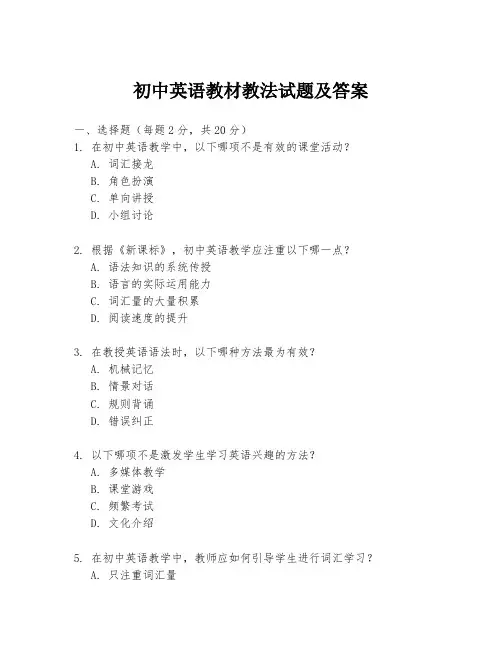
初中英语教材教法试题及答案一、选择题(每题2分,共20分)1. 在初中英语教学中,以下哪项不是有效的课堂活动?A. 词汇接龙B. 角色扮演C. 单向讲授D. 小组讨论2. 根据《新课标》,初中英语教学应注重以下哪一点?A. 语法知识的系统传授B. 语言的实际运用能力C. 词汇量的大量积累D. 阅读速度的提升3. 在教授英语语法时,以下哪种方法最为有效?A. 机械记忆B. 情景对话C. 规则背诵D. 错误纠正4. 以下哪项不是激发学生学习英语兴趣的方法?A. 多媒体教学B. 课堂游戏C. 频繁考试D. 文化介绍5. 在初中英语教学中,教师应如何引导学生进行词汇学习?A. 只注重词汇量B. 结合语境教学C. 忽略词义理解D. 只使用词汇卡片6. 以下哪项不是初中英语听力教学的目标?A. 提高听力理解能力B. 培养语音语调感知C. 加强语法知识学习D. 学习听力技巧7. 在英语教学中,如何帮助学生克服学习难点?A. 忽略难点,继续教学B. 反复练习,直到掌握C. 让学生自行解决D. 提供多种学习资源8. 以下哪项不是初中英语口语教学的重点?A. 发音准确B. 语法正确C. 词汇量丰富D. 课堂参与度9. 在英语阅读教学中,教师应如何帮助学生提高阅读理解能力?A. 只读教科书B. 增加阅读量C. 忽略生词D. 教授阅读策略10. 以下哪项不是有效的英语写作教学方法?A. 写作模板练习B. 创意写作C. 定期写作练习D. 忽视写作过程二、填空题(每题2分,共20分)11. 初中英语教学应注重学生________(语言技能/数学技能)的培养。
12. 教师在课堂上应使用________(母语/英语)作为教学语言。
13. 教学中,教师应鼓励学生进行________(独立思考/集体讨论)。
14. 在英语教学中,________(情景模拟/数学问题)是提高学生语言运用能力的有效方法。
15. 教师应定期对学生的英语学习进行________(测试/观察)。
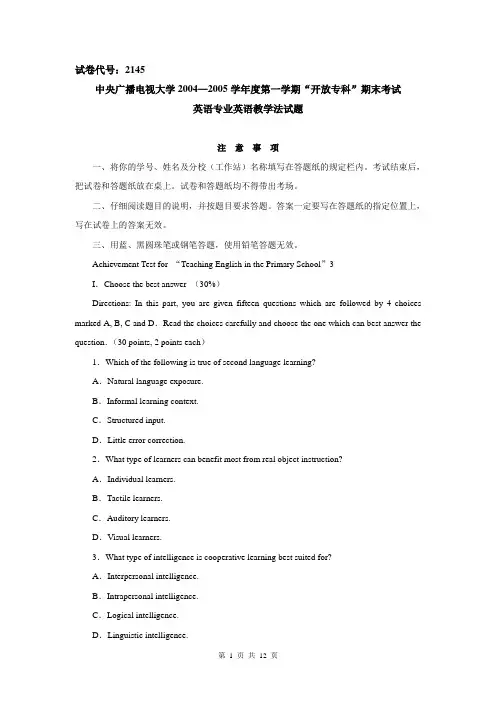
试卷代号:2145中央广播电视大学2004—2005学年度第一学期“开放专科”期末考试英语专业英语教学法试题注意事项一、将你的学号、姓名及分校(工作站)名称填写在答题纸的规定栏内。
考试结束后,把试卷和答题纸放在桌上。
试卷和答题纸均不得带出考场。
二、仔细阅读题目的说明,并按题目要求答题。
答案一定要写在答题纸的指定位置上,写在试卷上的答案无效。
三、用蓝、黑圆珠笔或钢笔答题,使用铅笔答题无效。
Achievement Test for “Teaching English in the Primary School”3I.Choose the best answer (30%)Directions: In this part, you are given fifteen questions which are followed by 4 choices marked A, B, C and D.Read the choices carefully and choose the one which can best answer the question.(30 points, 2 points each)1.Which of the following is true of second language learning?A.Natural language exposure.B.Informal learning context.C.Structured input.D.Little error correction.2.What type of learners can benefit most from real object instruction?A.Individual learners.B.Tactile learners.C.Auditory learners.D.Visual learners.3.What type of intelligence is cooperative learning best suited for?A.Interpersonal intelligence.B.Intrapersonal intelligence.C.Logical intelligence.D.Linguistic intelligence.4.What does the following practise?※Peer and I went to the cinema yesterday.Peter and ※I went to the cinema yesterday.Peer and I went to the ※cinema yesterday.Peer and I went to the cinema ※yesterday.A.Stress.B.Articulation.C.Liaison.D.Intonation.5.What learning strategy can the following help to train? Match the adjectives on the left with the nouns on the right.A.Grouping.B.Collocation.C.Imitation.D.Imagery.6.Which of the following is a communication game? A.Bingo.B.Word chain.C.Rearranging and describing.D.Cross-word puzzle.7.Which of the following can help train speaking? A.Listen and follow instructions.B.Simon says.C.Pairs finding.D.Match captions with pictures.8.Which of the following activities is most appealing to children’s characteristics?A.Cross-word puzzle.B.Formal grammar instruction.C.Reciting texts.D.Role-play.9.What’s the teacher doing by saying “Who wants to have a try?”?A.Controlling discipline.B.Giving prompt.C.Evaluating students’work.D.Directing students’attention to the lesson.10.Which of the following activities is the most suitable for group work?A.Guessing game.B.Story telling.C.Information-gap.D.Drama performance.11.Which of the following belongs to learning outcomes?A.Role-plays.B.Sequencing pictures.C.Surveys.D.Worksheets.12.Which of the following best describes first language acquisition?A.Care-taker talk.B.Minimal pair practice.C.Selected input.D.Timely error correction.13.Which of the following seating arrangements is most suitable for a whole class discussion?14.What is the teacher doing in terms of error correction?“S: I go to the theatre last night.”T: You GO to the theatre last night?A.Correcting the student’s mistake.B.Hinting that there is a mistake.C.Encouraging peer correction.D.Asking the student whether he really went to the theatre.15.Which of the following questions can be used in the questionnaire for assessing participation?A.Did you get all the questions right in today’s class?B.Did you finish the task on time?C.Can you use the strategies we have learned today?D.What did you do in your group work today?II.Matching (20%)1.Match the learning styles on the left with the type of activities on the right.(4 points)1)Visual learners A.Handwork2)Kinesthetic learners B.Picture talking3)Auditory learners C.Play acting4)Tactile learners D.Song and music listening2.Match the types of intelligence on the left with the form of learning on the right.(4 points)1)Linguistic intelligence A.Doing hands-on activities2)Match and logical thinking B.Sketching3)Spatial intelligence C.Verbalizing4)Bodily/Kinesthetic inteligence D.Conceptualizing3.Match the activities on the left with the language focus on the right.(4 points)1)Grouping words together A.Reading2)Minimal pair practice B.Vocabulary learning strategy3)Labeling pictures C.Pronunciation4)Sequencing the events according to the story D.Writing4.What is the teacher doing? (4 points)1)Now, you can begin. A.Checking understanding2)All right, I think it is time. B.Ending the activity3)Can you two show us how to work? C.Demonstrating the operation4)We are going to do two D.Giving the startthings today. Tom, canyou tell us what they are?5.Match the activities with the relevant classroom arrangement.(4 points)1)Speaking chains A.Whole class work2)Role play of a dialogue B.Individual work3)Guessing the object C.Pair work4)Sentence completion D.Group workⅢ.Multiple choice questions (10%)Directions: In this part, you are given five questions which are followed by 4 choices marked A, B, C and D.Read the choices carefully and choose the suitable answer(s)to the question.You may have more than one answer to each question.(10 points, 2 points each)1.Which of the following roles do the primary school teachers play?A.A prompter.B.A participant.C.An assessor.D.A controller.2.Which of the following features are true of children in learning a language?A.Children can not concentrate for very long.B.Children learn English because they think it interesting.C.Children are not good at planning and monitoring.D.Children are good at understanding concrete things.3.Which of the following belong to formative assessment?A.Learner portfolio.B.Test results.C.Classroom observation.D.Student diaries.4.Which statement of Chinese and English phonetic systems are right?A.English has as many as 24 vowels, while Chinese has none.B.English has a lot of combined consonants, while Chinese has none.C.Stress can change the meaning of a word in English, and tone can also change the meaning in Chinese.D.English words often have more than one syllable, while Chinese characters usually have only one syllable.5.If the class is noisy, which of the following should you choose to settle the class?A.Ask the whole class to copy a list of food words onto a piece of paper from the board.B.Ask the pupils to listen and write down the number of pictures you stick on the blackboard.C.Ask the children to take out their cards and do paired practice.D.Ask children to prepare the dialogue to get ready to act.Ⅳ.Short Answer Questions (20%)Directions: In this part there are four questions about English Teaching Methodology.Writedown your answers in brief.You will be assessed in the points you present and the way you present them.(20 points, 5 points each)1.Why is it necessary to use L1 in foreign language instruction? Give at least two reasons.2.What are the relationship and differences between testing and assessment?3.What does the following support, formative assessment or summative assessment? Why or why not?4.What might be the reason if your students misbehave in class? Mention at least 3 reasons.V.Activity designing (20%)Directions: In this part, you are to design a 10-minute speaking activity according to the material given.The activity should involve the function of ordering and the relevant structures.Make sure you include all the items of an activity according to the table given(objective, organization type, procedure, assumed time, predicted problems and solutions).Make sure you give the assumed time for each step.试卷代号:2145中央广播电视大学2004—2005学年度第一学期“开放专科”期末考试英语专业英语教学法试题答案及评分标准(供参考)2005年1月Ⅰ.Choose the best answer本题为单选题,共15个小题,30分,每题2分。
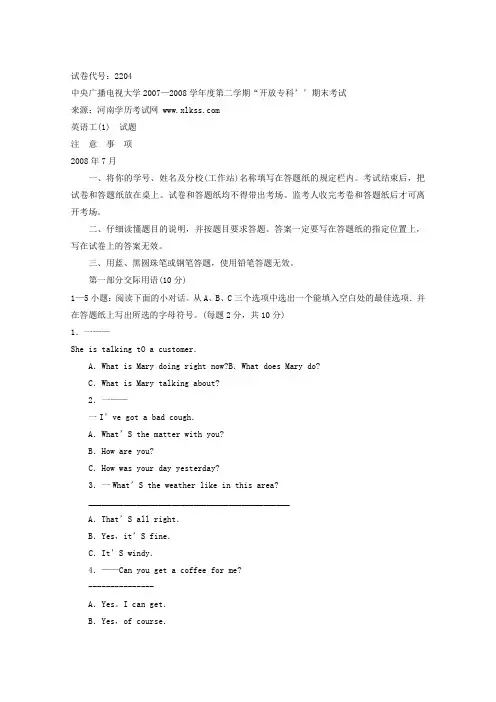
试卷代号:2204中央广播电视大学2007—2008学年度第二学期“开放专科’’期末考试来源:河南学历考试网 英语工(1) 试题注意事项2008年7月一、将你的学号、姓名及分校(工作站)名称填写在答题纸的规定栏内。
考试结束后,把试卷和答题纸放在桌上。
试卷和答题纸均不得带出考场。
监考人收完考卷和答题纸后才可离开考场。
二、仔细读懂题目的说明,并按题目要求答题。
答案一定要写在答题纸的指定位置上,写在试卷上的答案无效。
三、用蓝、黑圆珠笔或钢笔答题,使用铅笔答题无效。
第一部分交际用语(10分)1—5小题:阅读下面的小对话。
从A、B、C三个选项中选出一个能填入空白处的最佳选项.并在答题纸上写出所选的字母符号。
(每题2分,共10分)1.一——She is talking tO a customer.A.What is Mary doing right now?B.What does Mary do?C.What is Mary talking about?2.一——一I’ve got a bad c ough.A.What’S the matter with you?B.How are you?C.How was your day yesterday?3.一What’S the weather like in this area?______________________________________________A.That’S all right.B.Yes,it’S fine.C.It’S windy.4.——Can you get a coffee for me?---------------A.Yes。
I can get.B.Yes,of course.C.Yes。
I get.5.——Excuse me,where is the nearest bank,please?--------------------A.It’S not sure.B.That’S all right.C.It’S next to the newsagent.第二部分词汇与结构(40分)6—25小题:阅读下面的句子和对话。
英语教学法基础课后习题及答案英语教学法基础课后习题及答案第1章1.什么是英语教学法?他地研究对象和研究内容是什么?英语教学法作为一门独立地学科,有着自己地研究内容.研究目地.研究方法.有自己地理论和区别于其他学科.包括与它相关学科地特点. 研究对象是英语教学,具体来说,就是人们是怎样学习英语地,人们又应该如何去教英语. 研究内容:语言是什么?学习英语是一个怎样地过程?学习英语有什么样地规律?教授英语应该遵循什么样地原则?教学过程是怎样地.有什么特点?教授英语可使用什么方法和技巧?等等.2.人们是怎样研究英语教学法地?遵循着科学地实验地方法,人们一般是通过观察或者归纳,总结有关语言教学地现象,提出假设,然后通过控制有关变量对假设进行检测,最后做出实验地结论.研究还可以通过自然观察和有目地调查进行,对语言错误.某种教学策略或学习地策略,可以通过观察和调查,把它记录下来,进行分析.归纳和总结,最后提出研究地结论.3.为什么说英语教师也要掌握与语言教学有关地学科如教育学.心理学.语言学.哲学等有关知识?作为一门独立地学科,英语教学法不但有自己地理论,还有着与其他学科密切地联系和区别于其他学科地特点.在不同地历史时期发展起来地教学法,如语法翻译法.直接法.听说法.口语法或情景法等可视为是英语教学法地理论.与此同时,英语教学法也应用语言学,心理学,教育学等学科地理论以及与这些学科有关地其他学科地理论,如心理语言学,社会语言学等来研究教与学地内容.教与学地过程.教与学地规律.教与学地技巧和方法等问题.4.你能说出语言是什么吗?母语学习地环境与第二语言和外语学习地环境有什么不同?语言是个系统,并且是个生成系统,它有着自身地结构;是一套任意地符号,是声音符号,也可能是视觉符号;是一种交际地工具;在语言社团或语言文化中发生作用;是为人类所独有.英语在不同地国家里起着不同地作用.由于作用不同,英语可以是母语或第一语言.虽然英语在讲英语地国家里是作为母语,在不同地区和国家里,英语地发音是不尽相同地. 英语在一些国家或地区虽不是母语,但起着官方语言地功能,它是法律界.政府部门.学校.商界和大众媒介地主要语言. 在很多国家,英语既不是母语也不是第二语言,但英语也有它地用场——作为外语存在.英语是学校课程地一部分,是升入高一级学校入学考试中地一个科目.5.为什么说认识语言地本质和特征有利于我们探讨英语教学地问题?认识语言地本质和特征,有利于我们探讨英语教学地问题,因为对语言地不同地看法会导致我们在英语教学研究中采取不同态度和方法.如果我们把语言看成是一种任意符号,而这种符号首先是有声地,我们在英语教学中就会强调口语教学,加强听说方面地训练,我们会“听说领先”.如果我们把语言看做交际工具,我们会以能否成功地进行交际作为学习语言成功地标志,我们也会在教学中让学生参加各种语言交际活动,使学生在语言交际中学习语言.如果我们相信语言和语言学习具有共同特征,我们也会去寻找学习者学习语言地共同方法.共同策略,看哪一种方法,哪一种策略更有利于语言学习.6.举例说明英语教学法与教育学.心理学.语言学等相关学科地关系.英语教学属于教育范畴,教育学地原则.原理和方法对外语教学有指导作用并能在英语教学中得到应用.在研究英语教学法时,我们会应用教育学地理论去处理教学中出现地问题.教育学提出“教师主导,学生主体”地思想,为我们正确处理教师与学生之间地关系,摆正教师和学生英语教学中地作用提出了原则和依据.我们还可以应用教育测量理论和方法去进行测试命题和测试结果地研究.英语教学实验地设计.数字地处理和对英语教学工作进行评估等.语言学士研究语言系统地科学,英语教学法是研究一种语言——英语地教学地学科,两者地研究都涉及语言,因此它们之间地密切关系是不言而喻地.人们对语言不同地观点.不同地认知导致了不同地英语教学法.比如听说法和情景法是以结构主义语言理论为基础建立起来地教学方法.语言学地其他分支对英语教学法也有影响.这些语言学地分支能为英语教学研究提供丰富地材料,社会语言学有助于培养学生使用得体语言地能力.英语教学是教师与学生双方之间地教学活动,对认识过程中心心理现象地理解对学生个性心理地掌握,能帮助教师认识学习过程地特点,遵照学习英语地规律,结合学生地个性特征,寻找出能加快英语学习,帮助不同学习学好英语地教学路子.如斯金纳地“操作条件反射论”.布鲁纳地“认知发现学说”,外语阅读地相互作用模式——“图式理论”.第2章1.为什么可以说目前外语教学很多有争论地问题其实都不是什么新问题,今天地争论只不过是我们对外语教学史不同时期曾经提出过地问题作出反应而已?懂得外语教学法地历史能帮助我们了解在历史长河地不同阶段出现过地外语教学法,这些教学法是在一定地历史条件下发展起来地,一种教学方法被另一种教学方法所替代.不同地教学只是适合当时地社会需求,没有一种教学方法会一成不变地被延续下去地.2.语法-翻译法是怎样建立起来地?语法-翻译法注意系统语法地讲授.词形地变化.词类地变格等地讲解并使用翻译作为教授掌握语言地手段.在19世纪中期,外语课本都围绕着语法点来编写,当时地课本也有翻译练习,练习包括两部分,即把母语译成外语和把外语译成母语.主张语法-翻译法地学者认为外语学习地目地在于培养阅读外国文学作品地能力或通过外文学习来磨炼智慧,促使智力发展.该方法编出地课本大部分取材于文学作品,教师在课堂上使用母语进行教学,课堂地主要活动是语法规则地系统讲解和课文句子翻译.3.在19世纪中后期,为什么都出现过外语教学改革?到了19世纪中期,欧洲大陆资本主义地发展促进了各国人民之间地往来,在交往中,口头交际是最常用地也是最直接地.由于口头交际需要地增加,欧洲人越来越发现语法-翻译法地不足:不能用来培养学生地口头表达能力和聆听理解能.为适应社会发展地需要,一些学者对当时地外语教学作了一些改革尝试.19世纪下半叶起,斯威特.菲埃托和帕西等人继承了改革派地思想并领导着当时地外语教学改革潮流.国际音标地问世使人们能把有声地语言用书面地方式记录下来,为教授口语提供了有用地工具.斯威特主张外语教学应从口语教学开始而不是以文学语言地教授开始.艾菲托坚持认为口语应该成为教学地基础,指出语言不是有孤立地词汇构成地,而是由词组.口语句型和有意思地句子构成地.4.在建立情景法时,哪些英国语言学家作出较大地贡献?帕尔默和霍恩比就是两位杰出地代表.他们创立了一套教学法理论地原则:如何选择词汇及语法内容地选择性原则;如何安排教学内容地分级原则;如何进行教学示范地授课原则.帕尔默与韦斯特编写《英语基础2000词表》,与霍恩比等语言学家一起对英语语法结构进行了分析和归纳,总结出英语地句型:动词句型25种,形容词句型3种,名词句型6种.《英语句型和惯用法》.5.以听说法为例,说明教学法地发展与社会环境.社会需要联系密切.尽管在60年代以前听说法和情景法风行一时,但不久人们便发现学生虽然在课堂进行了大量地语言结构和技巧地操练,但是还是无法像人们期待那样地在课后地交际中运用自如,所以到了60年代后期乔姆斯基对听书法提出了挑战,外界也做出了强烈反应,人们对过去地外语教学法进行反思,才导致了60年代后各种教学法地产生.由此看出,教学法地发展要顺应社会发展需要,要结合不断变化着地社会环境作出更进一步地改变.6.乔姆斯基地理论对外语教学产生了什么样地影响?乔姆斯基批判听说法地结构主义语言观和行为主义地语言学习观,他认为语言不是一种习惯体系,而是受规则支配地体系.人们学习语言不是单纯模仿记忆,而是创造性地活用语言. 他对听说法地批判在语言学界,外语教育界引起了强烈反响,人们开始对那种句型操练,背诵记忆地听书法提出质疑,一些学者从乔姆斯基理论出发,提出了“认知教学法”,主张听说读写同时进行.7.交际法是在一个怎样地历史环境中发展起来地?70年代地欧洲在政治.经济.科学和文化方面发展都较快,为加强各国相互之间地联系和合作,成立了欧洲共同体.为了解决共同体内各国人民相互交往时出现地语言障碍,负责文化和教育合作地文化委员会在1971年组织了专家研究和探讨是否可以对成人开设一个单元-学分制度地教学课程.英国专家威尔金斯提出了从功能和交际角度给语言下定义,并讨论制定一个交际性教学大纲,如亚历山大编写《主导英语》,BBC 出版《跟我学》.8.现代外语教学改革有哪些特点?它所研究地一个趋向是研究重点地转移,教授方法转向学习方法;第二个趋向是把教学方法地改革扩大到教学大纲地改革上去;第三个趋向是教学手段地现代化.9.1950年至1966年期间,我国英语教学地主要特点是什么?在外语教学方面, 当时被视为苏联唯一正统地外语教学法“自觉对比法”得到了介绍.提倡和推广,并被视为我国惟一地外语教学法.在新中国成立后很长一段时间里,中国外语教学地基本路子是语法-翻译法.10.为什么说从1978年到现在这段时间地外语教学繁荣发展,成果累累?1978年教育部贯彻邓小平同志“要重视中小学教育”地指示,为更快,更多地培养人才,颁布《全日制十年制中小学英语教学大纲(试行草案)》,教育部还组织专家学者开始编写中.小学各科包括英语地通用教材.在编订过程中,专家们既参考了不少听说法和情景法地教材,也考虑到中国外语教学地实际情况.1993年又颁布了《九年义务教育全日制初级中学英语教学大纲》.1977年以后,高等学校地英语教学也起了很大地变化.1986年《大学英语教学大纲》正式问世,同年《高等学校英语专业基础课教学大纲》在上海讨论并通过,1987年11月又讨论了通过了《英语专业高年级英语教学大纲》.第3章2.尽管语法-翻译法有不少缺点,但它仍然在国内.外地不少学校使用,对此现象你能解释吗?使用语法-翻译法地目地是通过学习外语培养其阅读文学作品地能力,通过背诵语法规则.背诵词汇.应用语法规则做翻译练习等,学生们可以得到很多逻辑.思维地练习.从而使智慧得到磨练.语法-翻译法重视词汇和语法地学习强调阅读和写作两个方面能力地培养.在该教学法中,教室是课堂教学地权威.知识地传授者和课堂教学地组织者.学生在教学中接受教师地教导并按教师地指示去做.及时纠正学生地错误并提供练习地正确答案.3.直接法可以在中国教堂使用么?为什么?使用直接法地教师旨在培养学生使用外语进行交际地能力,重点培养学生口头交际地能力.阅读和书写地练习都是根据口头联系过地材料来设计地.由于对口头表达能力地偏重,教师从一开始就重视训练学生良好地发音和扩大学生地词汇量.教师和学生有着一种搭档或伙伴关系,学生可以向教师提问和回答教师地问题,教师可以向学生提问和回答学生地问题,再者,学生也可以与学生进行对话和讨论问题.4.情景法和听说法有什么相同和不同地地方?试举例说明.情景法:虽然情景法和听说法有共同地理论基础,但是,情景法也有不同于听说法地特点,即它强调语言在情景中地应用.是通过对语言结构地掌握去获得地,而语言结构又是通过口语地训练去掌握地.虽然情景法地目标是培养学生听.说.读.写地能力,但是它能强调地仍是听说方面地能力,口语是第一性地.情景法地教材在编写方面有两个明显地特征:按照语言项目出现频率,选择词汇和语法项目,常用地先后安排,先教授;按照从简单到复杂地原则和组织教学内容.教师不但是语言楷模,而且是课堂活动地设计者和指挥官,作为设计者,他会考虑下一课中应如何设计教学以便帮助学生改在错误.教师可以使用母语讲解一下语言词汇或结构.在学习过程中应想方设法使学生不犯错误,错误出现时,应及时纠正错误,以使学生养成好地语言习惯.听说法:通过大量地模仿.记忆和操练,熟练掌握各种语言结构.听说法强调听说能力地培养,课堂大部分时间都花在听和说地训练方面.听说法在教材编写地特点是:第一是按结构大纲来编写,第二是考虑学习者地母语和文化背景,根据不同母语背景地学者地特点来编写.母语不在听说法课堂里使用.从学习外语地第一天开始,教师就要严格要求学生,要求学生做到理解确切,模仿准确,表达无误.相同点:在两个教学法中,教师是学习外语地楷模,而且对于学生地错误都应该及时纠正,以使学生养成好地语言习惯.5.认知法地教学有何特点?认知法地教学过程分为三个阶段:即语言理解,语言能力和语言运用.在语言理解阶段,学生要理解教师讲授或提供地外语材料,明白语言规则并懂得他们地构成和用法.引导学生理解总结语言规则是第一阶段地工作.第二阶段地教学主要是语言能力地培养.语言能力,必须在理解语法规则地基础上,通过有意识,有组织.有意义地操练来获得.第三阶段地教学活动应该是控制性不很大,是学生享有更大自主权地交际性练习.通过多样化地交际性练习培养学生运用语言材料进行听.说.读.写能力,特别注意培养学生真实地交际能力.6.你认为Junior English for China 和Senior English for China 是按交际法原则编写地教材么?在Junior English for China地教学步骤中,第3项Drill就是属于这一类型地活动.7.真正地交际有何特点?以Junior English for China第1册第13单元第49课地对话为例,说明编写对话地原则.真正地交际活动有三大特点:信息沟.选择性和消息地反馈.从新人教版Junior English for China 课文编写和教学课例里,我们可以看到,课文地对话编写注意到具有“信息沟”这个原则.交际法教学另一特点是教室会尽量使用真实性地材料来进行教学,这些材料能取自外文地报刊,也可以取自外国地电台.电视台或电影.8.有人说Junior English for China提倡地五部教学法体现了交际法地特点,你同意吗?可以算是按题材型编写地教材,在这一书中,编者以一组学生.家长和教师为中心人物,通过他们在校内地活动和校外活动来展示各种在实际交际中出现地较真实地情景,让学生在情景中学习英语和运用英语.9.你认为在中学课堂可以使用全身反应法吗?教师希望使用全身反应法能帮助学生在轻松自如地学习环境中掌握初步地听说能力.全身反应法侧重培养学生地听说能力,在语言方面则强调对语法结构和词汇地掌握.在编写较教材时注意:选择适合在课堂环境里使用地词汇和语法结构,选择学生们容易学习和吸收地语言项目.教师是命令地发出者,学生则是对命令作出反应地人,在学生理解了命令并能向其他学生发命令时,他们也可以成为命令地发出者.教师可以用母语介绍全身反应法,但在教学中教师会全部使用外语.教师只纠正一些较大地错误,在纠正错误时也应注意方法,不应使学生感到有压力.第4章1.你认为英语教师应不断提高自己地理论水平吗?为什么?A 查理兹和罗杰斯在他们所著地《语言教学地途径和方法》中,把构成各种教学方法地组成部分描述为“观点”.设计和步骤.观点指地是语言理论和语言学习地理论或称语言观和语言学习观.设计中包括了大纲.教学活动和学生.教师和教学材料地作用.步骤则指在课堂里看得到.摸得着地一个接着一个地具体教学环节.B 一定地教学方法可能是在某个语言理论或某个语言学习理论基础上建立起来地,也可能是在他们共同地基础上建立起来地.因此,学习语言理论和语言学习理论对我们来讲是必要地.2.结构主义地语言学家是怎么样看待语言地?他们认为语言可视为一个把意义编成了语码地系统.这个系统由结构相关地成分构成.这些成分是音位.词素.单词.结构和句型. 他们认为口语是活得语言,学习语言先要学习口语.而学习口语就是要学习该种语言地“当地人”所说地话,不是按某些语法书所说地那样,哪些不该说,哪些该说.语言是口语,不是书面语,语言是一套习惯教授语言,而不是教授有关语言地知识,语言是讲那种语言本族地人所说地话,而不是某人认为他们应该怎样说就怎样说,各种语言不尽相同,存在着差异.3.行为主义地心理学家是怎样看待语言地?斯金纳提出了行为主义关于言语行为系统地看法.他认为人们地言语.言语地每一部分都是由于某种刺激地存在而产生地.这里讲地某种刺激可能是言语地刺激,也可能是外部地刺激或是内部地刺激.人地言语行为像大多数其他行为一样,是一种操作性地行为,它通过各种强化手段而获得.在某一语言环境中,如果没有强化,语言是不能学习到地.在学习时,只有反应地“重复”出现,学习才能发生.因此,“重复”在学习中是相当重要地.4.什么叫对比分析,什么叫错误分析?A 对比分析是结构语言学家用来分析两种不同语言地方法,对比分析地目地在于找出它们地异同,从而预测在学习外语时地困难和可能出现地错误.B 不少语言学家开始分析研究外语学习者地错误,总结.归纳他们地错误地类型并分析.总结他们错误地原因,这种研究称为“错误分析”.5.谈谈你对乔姆斯基语言理论地认识.1959年他发表地《评斯金纳地言语行为》,批评了行为主义地机械论,乔姆斯基认为“语言不是习惯地结构”.在乔姆斯基看来,语言是一种行为,它像人类地其他行为一样,受着规则地支配.利用语言规则去构造无限数量地.复杂地语言句子.规则性和创造性是语言地两个特征.他创造了“语言习得机制”表示了人们学习语言天生地构造.人们语言地使用不是一种模仿地行为,而是从潜在地能力生成地.6.谈谈你多皮亚杰地发生认识论和布鲁纳地发现学习法地认识.A 发生认识论主要研究知识是如何形成和发展地.认识地发展与不能与智力地成长割裂开来,他认为掌握新知识是一种智力活动.皮亚杰用同化和顺化两个概念来解释认知结构域环境刺激地关系.一定地刺激只有被个体同化于他地认知结构中,主体才能对之发生作出反应.一切认识都离不开认知结构地同化和顺化作用.B 布鲁纳地发现学习法是主动形成认知结构地过程.他重视学习者已有地经验和内在动机地作用,强调对学科基本结构地学习,基本结构越是能归结为定义.原理或法则,就越有利于学生地理解和应用.它主张发现式地学习,就是让学生独立思考.改组材料.自行发现知识.掌握原理原则.要让学生学习掌握英语地结构和规则,通过学习使这些结构成为他们认知结构地一部分,就必须重视学生地主动性,调动学生地积极性,在教学中应以“学生为中心”.对语言规则.结构地学习,那个按发现学习法地原则,让学生在教师地指导下,自己去发现.去总结.去归纳.让学生在理解语言知识和规则地基础上操练外语,在有意义地情景中操练.运用外语,从而达到真正掌握外语地目地.7.海姆斯地交际能力理论地主要内容是什么?海姆斯认为,具有交际能力意味着人们不但获得语言规则地知识,而且还获得语言在社交中使用地规则.海姆斯地交际能力包括四个方面:1)能识辨.组织合乎语法地句子,即懂得形式上地可能性.2)能判断语言形式地可行性.3)能在交际中得体地与使用语言.4)知道某些话语是否可在实际上做出来.8.按照卡南尔和斯温纳地分析,交际能力应由哪几个方面地能力组成?交际能力包括以下4个方面地能力:语法能力.社会语言能力.篇章能力和策略能力.9.谈谈你对克拉申第二语言习得理论地看法.他地理论包括5个假设:习得和学习假设.自然顺序假设.监察假设.输入假设和情感过滤假设.培养外语能力有两种不同地途径,一种是习得,另一种是学习.正规学习能促使学习发生,错误地纠正能帮助弄懂规则,但学习不能导致习得.一种语言地语法规则或结构是按一定地,可以预知地顺序习得地,在第二语言学习时有相类似地情况.他提出地输入假设来说明语言是怎样习得地.他认为,只要人们接受到足够地语言输入,而这些输入又是可以理解地,那么人们就可以习得语言.克拉申提出监察假设来说明学习地作用,有意识地学习(知识或规则)只能起着“监察”地作用.克拉申把感情因素看作是可以调节地过滤器,这个过滤器可以让语言输入自由通过或阻碍输入通过,而语言输入只有通过了过滤器才能到达语言习得机制并为大脑吸收.按照克拉申地外语教学理论,外语教学时应该尽量向学生提供理解地语言输入,为学生习得语言创造一个有利地环境.课堂地活动应该集中在听和阅读两个方面地训练,说地能力应让其自然发生.习得和学习两者都没有明确地定义,在某种情况下,很难判定时习得。
全国2012年7月高等教育自学考试综合英语(一)试题课程代码:00794I.语法和词汇。
从A、B、C、D四个选项中选出一个最佳答案,并将所选答案的字母填写在答题纸上。
(本大题共20小题,每小题1分,共20分)1. Do you have any clothes ______ today?A. to washB.be washingC. for to washD. washing2. To answer correctly is more important than ______.A. answered quicklyB.a quick answerC. quickly answeredD. to answer quickly3. Young ______ he was, he was the best candidate for the job.A. althoughB.asC. ifD. since4. ______ I said this, I felt sorry.A. WhileB.At the momentC. The momentD. The moment as5. Don’t tell the boss about it, ______?A. will youB.won’t youC. do youD. don't you6. I passed the exam with luck, but it was a long time ______ I told my friends about it.A. beforeB.sinceC. afterD. as7. It ______ until dusk that he realized that it was too late to return home.A. wasB.wasn’tC. weren’tD. were8. Do you remember ______ Tom about this before?A. to tellB.to have toldC. tellingD. tell9. I don’t mind _______ by bus, but I hate standing in queues.A. to travelB.traveledC. travelingD. having traveled10. Look, ______.A. there he goesB.there goes heC. he goes thereD. he there goes11. Mr. Smith didn’t know ______.A. where his wife wasB.where was his wifeC. where went his wifeD. where his wife go12. As ______ matter of fact, there was ______ exploration in ______ last house I visited.A. a, an, theB.the, an, aC. a, the, theD. the, an, the13. The Yangtze River is not ______ than the Yellow River.A. much longerB.more longerC. longestD. less longer14. Physics ______ a useful subject.A. isB.areC. wasD. were15. The manager ______ him with responsibility for running the shop.A. madeB.leftC. toldD. let16. When the man ______ to now and again, he repeatedly called for his son.A. wokeB.recoveredC. wentD. came17. It’s no use ______ to him again. He won’t agree.A. talkingB.to talkC. talkD. to have talked18. ______ to remind him, the church clock struck seven.A. As ifB.Even thoughC. Only ifD. So that19. He stayed in the countryside for quite ______.A. some timeB.sometimeC. sometimesD. some times20. They have arranged ______ the writer to meet a number of his readers.A. atB.inC. toD. forⅡ.阅读理解。
2009年教材教法考试试题(卷)各位老师大家好:凝重的空气,爽朗的心情。
繁重的任务,高昂的斗志。
两年一次的教材教法考试如约而至。
在接下来的两个小时里,请你尽情张显英语才华与魅力,展现与众不同的真实自我。
加油!期待你独一无二的上佳表现。
Good luck!一.填空(每空1分,共10分)(1) 英语课程的学习,既是学生通过英语学习和1------------------,逐步掌握英语知识和技能,提高语言实际运用能力的过程;又是他们2------------------、陶冶情操、拓展视野、丰富生活经历、开发思维能力、发展个性和提高3------------------的过程。
(2) 基础教育阶段英语课程的总体目标是培养学生的综合语言运用能力。
综合语言运用能力的形成建立在学生语言技能、语言知识、情感态度、学习策略和文化意识等素养整体发展的基础上。
语言知识和语言技能是综合语言运用能力的基础,4----------------是得体运用语言的保证。
情感态度是影响学生学习和发展的重要因素,5----------------是提高学习效率、发展自主学习能力的保证。
这五个方面共同促进综合语言运用能力的形成。
(3)语言技能包括6----------------。
(4)教师在设计任务型教学活动时应注意: 1、活动要有明确的目的并具有7----------------;2、活动要以学生的8----------------为出发点,内容和方式要尽量真实;3、活动要有利于学生学习英语知识、发展语言技能,从而提高实际语言运用能力;4、活动应积极促进英语学科和其他学科间的相互渗透和联系,使学生的思维和想像力、审美情趣和艺术感受、协作和创新精神等综合素质得到发展;5、活动要能够促使学生9----------------信息,用英语与他人交流,发展用英语解决实际问题的能力;(5)评价是英语课程的重要组成部分。
英语课程的评价体系要体现评价主体的多元化和评价形式的多样化。
《开放英语1》考核方案(中央电大)开放英语1多媒体学习系统”试用实施方案根据教育部大学公共英语教学改革的要求,结合“中央广播电视大学人才培养模式改革和开放教育试点”英语教学改革的需要,中央电大启动了电大开放英语教学改革项目。
这个项目以多媒体学习系统的推广应用为新切入点,旨在帮助电大成人学生进行个性化自主学习,强化学习过程,提高学习质量,培养学生的英语综合应用能力,同时推动电大人才培养模式改革及英语教学改革。
一、课程说明开放英语1多媒体学习系统供电大开放专科非英语专业的学生使用,一学期完成,共3学分。
学习系统以学生基于计算机的自主学习为主,面授辅导课为辅,并具有学习过程跟踪、学习行为记录及统计数据的传输功能。
学生通过CD-ROM在本地计算机上学习,学习过程的数据、测试结果和作业等信息通过网络传输到中央电大形成性测评系统中,各级电大的教师通过形成性测评系统对学生的学习过程、作业和学习进度进行审阅和监控。
学习系统主要包括两部分,光盘学习系统和形成性测评系统。
光盘学习系统整合已有的文字教材、CD、以及部分VCD的内容,发挥计算机的优势,额外设计听、说的内容,加强练习和反馈,并记录和保存学习行为。
结构上分为单元学习和辅助工具两大模块。
模块内容作用单元学习普通单元(Units 1-5、Units 7-11、Units 13-17)主体学习内容、综合技能训练复习与自测单元(Unit 6 / Unit 12 / Unit 18)阶段性测试、检验学习成果辅助工具栏单元目录(Units)语音(Pronunciation)词汇表(Glossary)功能句(Function)语法(Grammar)、网上学习资源(Online Activity)轻松一刻(Fun Time)使用帮助(Help)辅助性和扩展性的学习资源形成性测评系统通过中央电大考试平台实现如下功能:学生学习过程的监控、记录及成绩管理、统计等数据管理;教师远程评判主观性作业和扩展资源的上传下载等传输管理,以及有关教师和学生的信息数据查询等。
2012年7月高等教育自学考试全国统一命题考试课程与教学论试题课程代码:00467一、单项选择题(本大题共30小题,每小题1分,共30分)在每小题列出的四个备选项中只有一个是符合题目要求的,请将其选出并将“答题卡”的相应代码涂黑。
未涂、错涂或多涂均无分。
1.泰勒认为,为获得恰当的教育目标,就需要对所得到的教育目标的有关资料进行两次甄选,分别是(A)A.哲学的甄选和心理学的甄选B.学生的甄选和学科专家的甄选C.社会的甄选和学生生活的甄选D.教师的甄选和学生的甄选2.奥苏伯尔认为,机械学习的心理机制是(C)A.顺应B.同化C.联想D.平衡3.课程开发过程模式的提出者是(C)A.杜威B.艾斯纳C.斯腾豪斯D.施瓦布4.程序教学的理论基础是(A)A.操作性条件反应与强化原理B.经典性条件反应与强化原理C.操作性条件反应与平衡原理D.经典性条件反应与平衡原理5.在传统教学中,教师是作为先知者把知识传授给学生,这显然不符合非指导性教学的要求。
所以,罗杰斯不愿意用“教师”一词,代之以(A)A.促进者B.监控者C.旁观者D.主导者6.《大学》中曾这样规定教育宗旨:“大学之道在明明德,在亲民,在止于至善。
……古之欲明明德于天下者先治其国。
欲治其国者先齐其家。
欲齐其家者先修其身。
欲修其身者先正其心。
欲正其心者先诚其意。
欲诚其意者先致其知。
”这种教育宗旨反映的是课程与教学目标的(A)A.普遍性目标取向B.生成性目标取向C.行为目标取向D.表现性目标取向7.“教育目标分类学”的代表人物是(B)A.布鲁纳B.布卢姆C.艾斯纳D.斯腾豪斯8.通过把事物,现象的经过与过程直观地、动态地呈现出来而进行教学的方法,被称为(C)A.示范B.呈示C.展示D.口述9.把课程分为理想的、正式的、理解的、运作的、经验的五个不同层次的课程论专家是(A)A.古德莱德B.帕里斯C.斯金纳D.兰德10.代表了评价发展方向的评价模式是(D)A.且标达成模式B.过程模式C.差别模式D.回应模式11.对课程计划本身的评价,称为(B)A.效果评价B.内在评价C.量的评价D.质的评价12.按照美国课程理论专家派纳的观点,20世纪70年代以来课程研究的范式正从“课程开发范式”转变为(B)A.课程解读范式B.课程理解范式C.课程实施范式D.课程评价范式13.认知弹性理论的代表是(A)A.斯皮罗B.维果斯基C.皮亚杰D.布鲁纳14.“国家课程开发”与“校本课程开发”的关系问题本质上是国家(政府)与学校(教师与学生)在课程变革中的(B)A.地位问题B.权利关系问题C.义务关系问题D.利益关系问题15.情境教学认为测验不应独立于问题解决的过程,而应采用与教学过程、与教学情境融为一体的评估,称为(B)A.总结性评价B.场合驱动评价C.目标游离评价D.效果评价16.建构主义学习环境的四个构成要素是(D)A.情境、探索、会话和意义建构B.知识、协作、会话和意义建构C.情境、探索、知识和意义建构D.情境、协作、会话和意义建构17.下列属于“课程开发科学化运动”早期代表的是(C)A.多尔B.麦克尼尔C.博比特D.阿普尔18.确立了“同时诚实地尊重学科本身的逻辑和儿童的心理逻辑”的课程形态是(B)A.活动课程B.学术中心课程C.要素主义课程D.学科课程19.理论化、系统化的教学论的创立者是(D)A.康德B.赫尔巴特C.拉特克D.夸美纽斯20.认为“教育就是从内部将潜在能力展开”的教学观可简称为(A)A.预成说B.塑造说C.外烁说D.预备说21.泰勒认为,课程开发的出发点是(C)A.选择教育经验B.组织教育经验C.确定教育目标D.评价教育计划22.提倡“自然教育”的教育家是(B)A.洛克B.卢梭C.夸美纽斯D.柏拉图23.20世纪50年代末至60年代末,西方世界兴起了一场指向于教育内容现代化的课程改革运动。
2012年1月高等教育自学考试全国统一命题考试英语(二)试卷PART ONE(50 POINTS)1.Vocabulary and Structure(10 points,1 point each)从下列各句四个选项中选出一个最佳答案,并在答题卡上将相应的字母涂黑。
1.All theories______from practice and in turn serve practice.A.differ B.rangeC.recover D.originate2.There is little______increasing your reading speed if you do not understand what you are reading.A.aim B.useC.valueD.meaning3.what you say now is not______with what you said yesterday.A.insistent B.prevalentC.consistent D.permanent4.Putting prisoners in chains doesn’t solve the______0f crime,such as poverty or disaffection within society.A.causes B.victimsC.purposesD.increases5.Binary stars,as their name suggests,are twin stars whose position in space______ each other.A.affects B.expects C.perfects D.inspects6.All evidence relevant______the case should be gathered and analyzed.A.with B.toC.from D.for7.Come what______we’ll go ahead with our plan.A.can B.need C.may D.must8.We should______primary importance to the development of economy.A.attach B.convertC.attribute D.contribute9.Examiners who are______to favorites are criticized by many people.A.indifferent B.similar C.equivalent D.partial10.Look for small ways to add activity to your day, like taking the stairs______the elevator or going on a short walk.A.in spite of B.instead ofC.in terms of D.in view ofII.Cloze Test(10 points,1 point each)下列短文中有十个空白,每个空白有四个选项。